

Community Blog
Keep up-to-date on postgraduate related issues with our quick reads written by students, postdocs, professors and industry leaders.
Thesis and Dissertation Appendicies – What to Include
- By DiscoverPhDs
- August 12, 2020

An appendix is a section at the end of a dissertation that contains supplementary information. An appendix may contain figures, tables, raw data, and other additional information that supports the arguments of your dissertation but do not belong in the main body.
It can be either a long appendix or split into several smaller appendices. Each appendix should have its own title and identification letters, and the numbering for any tables or figures in them should be reset at the beginning of each new appendix.
Purpose of an Appendix
When writing the main body of your dissertation, it is important to keep it short and concise in order to convey your arguments effectively.
Given the amount of research you would have done, you will probably have a lot of additional information that you would like to share with your audience.
This is where appendices come in. Any information that doesn’t support your main arguments or isn’t directly relevant to the topic of your dissertation should be placed in an appendix.
This will help you organise your paper, as only information that adds weight to your arguments will be included; it will also help improve your flow by minimising unnecessary interruptions.
Note, however, that your main body must be detailed enough that it can be understood without your appendices. If a reader has to flip between pages to make sense of what they are reading, they are unlikely to understand it.
For this reason, appendices should only be used for supporting background material and not for any content that doesn’t fit into your word count, such as the second half of your literature review .
What to Include in a Dissertation Appendix
A dissertation appendix can be used for the following supplementary information:
Research Results
There are various ways in which research results can be presented, such as in tables or diagrams.
Although all of your results will be useful to some extent, you won’t be able to include them all in the main body of your dissertation. Consequently, only those that are crucial to answering your research question should be included.
Your other less significant findings should be placed in your appendix, including raw data, proof of control measures, and other supplemental material.
Details of Questionnaires and Interviews
You can choose to include the details of any surveys and interviews you have conducted. This can include:
- An interview transcript,
- A copy of any survey questions,
- Questionnaire results.
Although the results of your surveys, questionnaires or interviews should be presented and discussed in your main text, it is useful to include their full form in the appendix of a dissertation to give credibility to your study.
Tables, Figures and Illustrations
If your dissertation contains a large number of tables, figures and illustrative material, it may be helpful to insert the less important ones in your appendix. For example, if you have four related datasets, you could present all the data and trend lines (made identifiable by different colours) on a single chart with a further breakdown for each dataset in your appendix.
Letters and Correspondence
If you have letters or correspondence, either between yourself and other researchers or places where you sought permission to reuse copyrighted material, they should be included here. This will help ensure that your dissertation doesn’t become suspected of plagiarism.
List of Abbreviations
Most researchers will provide a list of abbreviations at the beginning of their dissertation, but if not, it would be wise to add them as an appendix.
This is because not all of your readers will have the same background as you and therefore may have difficulty understanding the abbreviations and technical terms you use.
Note: Some researchers refer to this as a ‘glossary’, especially if it is provided as an appendix section. For all intended purposes, this is the same as a list of abbreviations.
Finding a PhD has never been this easy – search for a PhD by keyword, location or academic area of interest.
How to Format a Dissertation Appendix
In regards to format, you can include one lengthy appendix or structure it into several smaller appendices.
Although the choice is yours, it is usually better to opt for several different appendices as it allows you to organise your supplementary information into different categories based on what they are.
The following guidelines should be observed when preparing your dissertation appendices section:
- Each appendix should start on a new page and be given a unique title and identifying letter, such as “Appendix A – Raw Data”. This allows you to more easily refer to appendix headings in the text of your main body should you need to.
- Each appendix should have its own page numbering system, comprising the appendix identification letter and the corresponding page number. The appendix identification letter should be reset for each appendix, but the page number should remain continuous. For example, if ‘Appendix A’ has three pages and ‘Appendix B’ two pages, the page numbers should be A-1, A-2, A-3, B-4, B-5.
- The numbering of tables and figures should be reset at the beginning of each new appendix. For example, if ‘Appendix A’ contains two tables and ‘Appendix B’ one table, the table number within Appendix B should be ‘Table 1’ and not ‘Table 3’.
- If you have multiple appendices instead of a single longer one, insert a ‘List of Appendices’ in the same way as your contents page.
- Use the same formatting (font size, font type, spacing, margins, etc.) as the rest of your report.
Example of Appendices
Below is an example of what a thesis or dissertation appendix could look like.
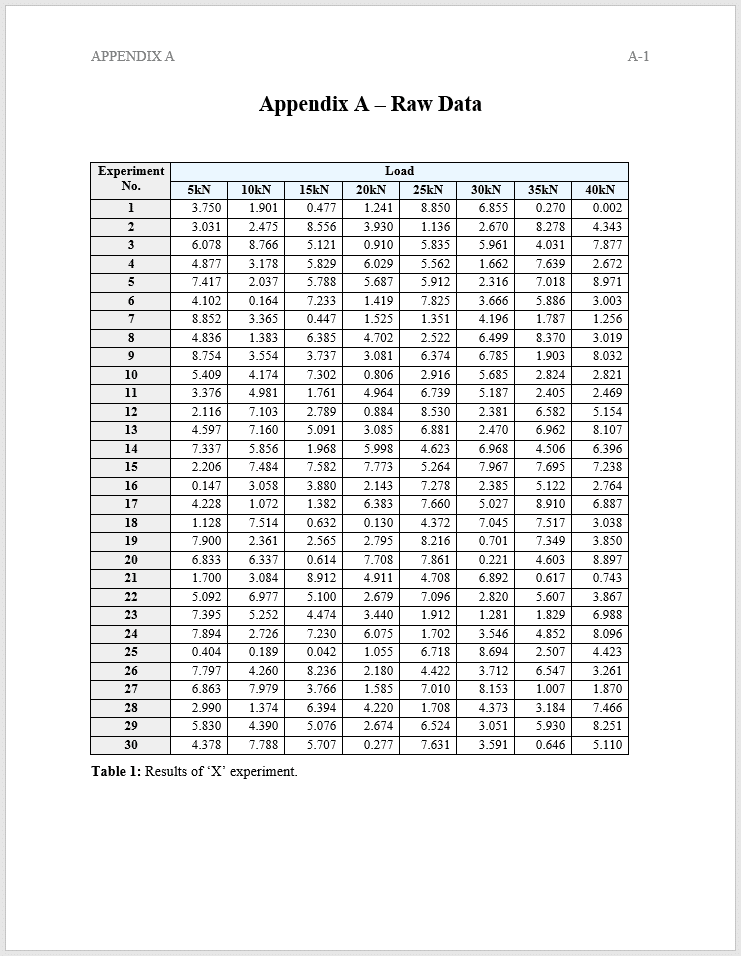
Referring to an Appendix In-Text
You must refer to each appendix in the main body of your dissertation at least once to justify its inclusion; otherwise, the question arises as to whether they are really needed.
You can refer to an appendix in one of three ways:
1. Refer to a specific figure or table within a sentence, for example: “As shown in Table 2 of Appendix A, there is little correlation between X and Y”.
2. Refer to a specific figure or table in parentheses, for example: “The results (refer to Table 2 of Appendix A) show that there is little correlation between X and Y”.
3. Refer to an entire appendix, for example: “The output data can be found in Appendix A”.
Appendices vs Appendixes
Both terms are correct, so it is up to you which one you prefer. However, it is worth noting that ‘appendices’ are used more frequently in the science and research community, so we recommend using the former in academic writing if you have no preferences.
Where Does an Appendix Go?
For a dissertation, your appendices should be inserted after your reference list.
Some people like to put their appendices in a standalone document to separate it from the rest of their report, but we only recommend this at the request of your dissertation supervisor, as this isn’t common practice.
Note : Your university may have its own requirements or formatting suggestions for writing your dissertation or thesis appendix. As such, make sure you check with your supervisor or department before you work on your appendices. This will especially be the case for any students working on a thesis.

There’s no doubt about it – writing can be difficult. Whether you’re writing the first sentence of a paper or a grant proposal, it’s easy

Statistical treatment of data is essential for all researchers, regardless of whether you’re a biologist, computer scientist or psychologist, but what exactly is it?

Multistage sampling is a more complex form of cluster sampling for obtaining sample populations. Learn their pros and cons and how to undertake them.
Join thousands of other students and stay up to date with the latest PhD programmes, funding opportunities and advice.

Browse PhDs Now

Reference management software solutions offer a powerful way for you to track and manage your academic references. Read our blog post to learn more about what they are and how to use them.

Sabrina’s in the third year of her PhD at The University of Adelaide. Her esearch combines molecular techniques, data analysis, and next generation sequencing to investigate modifications on RNAs in plants.

Dr Hooper gained his PhD in evolutionary biology from the the University of Sheffield. He is now a journalist and writer (last book called Superhuman) and podcast editor at New Scientist.
Join Thousands of Students
The Graduate College at the University of Illinois at Urbana-Champaign
Appendix(es) (optional).
Refer to either the Sample (Straight Numbering) or Sample (Decimal Numbering) pages as you read through this section. Note: For the Appendices, you should use the same numbering style you chose for the Main Text.
The appendix is a section that is placed at the end of the thesis and may contain material such as tables, figures, maps, photographs, raw data, computer programs, musical examples, interview questions, sample questionnaires, CDs, and many other types of material.
- An appendix is considered a chapter equivalent and the appendix title should be formatted like a chapter title.
- Multiple appendices should be numbered A, B, C, and so on. Each appendix should be treated as a separate chapter equivalent and will therefore start on a new page.
- Page numbers used in the appendix must continue from the main text.
- As a best practice, include your IRB approval letter (if applicable) in an appendix.
- Do not include a curriculum vitae or author's biography in your thesis; the Graduate College no longer accepts these sections.
As part of the thesis, any appendix materials must be reviewed and approved by the director of research and committee.
The thesis or dissertation itself should be understandable without the supplemental appendix materials.
As part of the ETD submission, students may upload supplemental electronic files as part of their thesis or dissertation. These files are considered appendix items, and an appendix page must be included as part of the thesis and should be numbered accordingly. This page should include an appendix title, such as “Appendix A: Interview Transcriptions,” and a brief description of the material along with the name of the file in which the material is contained.

- Library Catalogue
Formatting your thesis: Appendices & supplemental material

On this page
Introduction, materials included in appendices, supplementary material or research data files, order of appendices, appendix headings, formatting help.
Appendices provide supplementary information to the main thesis and should always appear after the references/bibliography. If you are unsure about whether content should be included in the thesis or in an appendix, consult with your supervisor. The thesis and appendices must be uploaded in a single file.
For more information about appendices, please see the Thesis Template Instructions .
Note: Signatures, personal phone numbers, or personal email addresses (ones that contains part of a person’s name) must be redacted from your thesis. This means that the text is fully removed, and cannot be copied & pasted out of the document.
If including copyrighted materials as appendices, see Copyright at SFU .
Examples of material included in appendices are as follows--also refer to Formatting Help .
- interview questions
- participant letters / forms
- surveys / questionnaires (if not your own work, these require copyright permission)
- supplemental tables / figures / graphs / image
Supplementary material or research data files associated with your thesis can also be uploaded to your library submission record. We recommend publishing such files to Summit (the SFU Research Repository) as they will be available alongside your thesis. This is preferred to hosting such files externally or on personal cloud storage.
Temporary instructions : Contact [email protected] if you wish to upload such files with your thesis submission -- please do not upload them to the Thesis Registration System at this time. Data Services will require basic descriptive information for each of your files and will also help you organize your research data appropriately pending publication.
If you are including supplementary material or research data files in your submission, you must include an appendix within your thesis document which contains an overall description of the supplementary material or research data files, authorship credits, and file name(s). This assists in “linking” your thesis document to any additional files, as well as providing further information and context about the file(s). The maximum file size for each file is 2GB. If you have a larger file size, please contact [email protected] .
Appendix examples:
- video file example
- data file example
Note : if your Ethics approval requires that supplementary material or research data files be destroyed after a certain period, then such files cannot be published to Summit (the SFU Research Repository). Please contact [email protected] to identify other possible solutions in this case.
Accepted supplementary material or research data file types:
aac, cif, csv, docx, dta, epub, exe, gdb, geojson, gif, iso, jp2, jpg, jpeg, json, kml, kmz, las, mp3, mp4, mpv, odt, pdf, png, pptx, py, qgs, qgz, r, rar, rmd, rtf, shp, tex, tif, tiff, txt, wav, xlsx, zip
It is recommended to use the best file formats to allow for data files to be openly accessible for the long term, so that they remain usable through software upgrades and changes in the computing environment. See the Research Data Management (RDM) website for more information about the handling and organization of data during your research.
Appendices appear in the order in which they are introduced in the text.
You may include one appendix or a number of appendices.
If you have more than one appendix, you would letter each accordingly (i.e., Appendix A, Appendix B, etc.). Write your appendix headings in the same manner as your chapter headings.
- Transfer the text and re-format using the template styles as necessary, or
- Convert the documents into images and insert them into your document, one image per page.

- Langson Library
- Science Library
- Grunigen Medical Library
- Law Library
- Connect From Off-Campus
- Accessibility
- Gateway Study Center

Email this link
Thesis / dissertation formatting manual (2024).
- Filing Fees and Student Status
- Submission Process Overview
- Electronic Thesis Submission
- Paper Thesis Submission
- Formatting Overview
- Fonts/Typeface
- Pagination, Margins, Spacing
- Paper Thesis Formatting
- Preliminary Pages Overview
- Copyright Page
- Dedication Page
- Table of Contents
- List of Figures (etc.)
- Acknowledgments
- Text and References Overview
- Figures and Illustrations
- Using Your Own Previously Published Materials
- Using Copyrighted Materials by Another Author
- Open Access and Embargoes
- Copyright and Creative Commons
- Ordering Print (Bound) Copies
- Tutorials and Assistance
- FAQ This link opens in a new window
Appendices within manuscript
Appendices may be included as part of the manuscript. These typically appear after the Bibliography or References section.
- List the Appendices in the Table of Contents
- Do not restart page numbering for your Appendices. For example, if the last page of your Bibliography is 195, your first Appendix page number should be 196.
Appendices as supplemental files
Electronic or audiovisual data may be included as Supplemental Files in an ETD submission. Your committee should agree that the information contained in the supplemental files is of such a character that a medium other than text is necessary.
When uploading your manuscript to ProQuest, there is a place to upload Supplemental Files separate from the main PDF upload (see screen capture below).

- << Previous: Figures and Illustrations
- Next: IV. Using Previously Published Material >>
- Last Updated: Sep 30, 2024 10:51 AM
- URL: https://guides.lib.uci.edu/gradmanual
Off-campus? Please use the Software VPN and choose the group UCIFull to access licensed content. For more information, please Click here
Software VPN is not available for guests, so they may not have access to some content when connecting from off-campus.
- +44 (0) 207 391 9069
- PhD Chapters
- PhD Proposals
- Viva Preparation
- PhD Applications
- Personal Statements
- Proofreading & Editing
- PhD Application
Writing the Appendix of Your PhD Thesis: a Guide
16th April 2024
Speak right now to our live team of English staff
A PhD thesis serves as the culmination of years of scholarly investigation and analysis. Alongside the main body of the thesis, appendices play a crucial role in providing additional context, data, and materials that support and enrich the research presented. This guide delves into the purpose and practicalities of writing the appendix of your PhD thesis, offering insights on how to effectively incorporate and utilise these supplementary sections to enhance the overall quality and depth of your doctoral dissertation.
What Are PhD Thesis Appendices Exactly?
PhD thesis appendices are additional sections that accompany the main text of a doctoral dissertation. They serve to provide detailed information that complements the core content of the thesis, offering readers supplementary data, charts, tables, code snippets, questionnaires, or other relevant materials.
Purpose of PhD Thesis Appendices
The primary purpose of appendices is to enhance the comprehensiveness and integrity of the research presented. An appendix allows you to include detailed data, technical information, or extensive documentation that may be necessary for a complete understanding of the study but would disrupt the flow if included within the main body of the thesis.
How to Write a PhD Thesis Appendix
- Identify Relevant Materials: Determine which supplementary materials are essential for supporting your thesis. Consider including raw data, detailed methodologies, lengthy code samples, survey instruments, interview transcripts, or additional explanatory content.
- Organise Content Effectively: Arrange the appendices in a logical order that aligns with the main text of the thesis. Number the appendices sequentially (e.g., Appendix A, Appendix B) and provide clear titles or descriptions for each.
- Provide Context and Explanations: Introduce each appendix with a brief overview or explanation of its purpose and relevance to the main thesis. This contextual information helps readers understand the significance of the included materials.
- Maintain Consistent Formatting: Adhere to the formatting guidelines specified by your academic institution or department. Ensure that fonts, margins, page numbering, and referencing within the appendices align with the overall thesis format.
What to Include in PhD Thesis Appendices
The content of PhD thesis appendices can vary depending on the nature of the research, but common elements to consider include:
- Raw data sets
- Detailed experimental procedures
- Technical drawings or diagrams
- Supplementary tables or figures
- Transcripts of interviews or focus group discussions
- Copies of questionnaires or surveys
- Code snippets or algorithms
- Additional literature reviews or supporting documentation
Considerations for Length and Formatting
When determining the length and formatting of PhD thesis appendices:
- Balance Conciseness with Completeness: Appendices should be comprehensive enough to support the thesis but concise enough to avoid overwhelming the reader.
- Follow Institutional Guidelines : Adhere to specific guidelines provided by your university or department regarding appendix length, formatting, and style.
- Use Clear Referencing: Ensure that each appendix is clearly labelled and referenced within the main text of the thesis to guide readers to relevant supplementary materials.
In conclusion, understanding how to effectively utilise PhD thesis appendices is essential for enhancing the comprehensiveness and impact of your doctoral dissertation. By strategically incorporating supplementary materials such as data sets, methodologies, and additional documentation, you can provide readers with a deeper insight into your research process and findings.
Embarking on a PhD journey is a significant undertaking, and having the right support and resources can make a world of difference. If you’re seeking assistance with crafting PhD chapters, appendices, or any aspect of your doctoral research we can help. Contact us today to explore how we can support and enhance your PhD journey with specialised academic services designed to meet your unique needs and challenges.
You may also like...
What is agile methodology: principles, methods, benefits, what are footnotes: definition, procedure, examples, a detailed guide to writing a thesis introduction: tips and examples, blog categories.

Online Plagiarism Checker for Academic Assignments
Start Plagiarism Check
Editing & Proofreading for your Academic Assignments
Get it proofread now
Free Express Delivery to All Places in the UK
Configure binding now
- Academic essay overview
- The writing process
- Structuring academic essays
- Types of academic essays
- Academic writing overview
- Sentence structure
- Academic writing process
- Improving your academic writing
- Titles and headings
- APA style overview
- APA citation & referencing
- APA structure & sections
- Citation & referencing
- Structure and sections
- APA examples overview
- Commonly used citations
- Other examples
- British English vs. American English
- Chicago style overview
- Chicago citation & referencing
- Chicago structure & sections
- Chicago style examples
- Citing sources overview
- Citation format
- Citation examples
- university essay overview
- Application
- How to write a university essay
- Types of university essays
- Commonly confused words
- Definitions
- Dissertation overview
- Dissertation structure & sections
- Dissertation writing process
- autumnacies
- Graduate school overview
- Application & admission
- Study abroad
- Harvard referencing overview
- Language rules overview
- Grammatical rules & structures
- Parts of speech
- Punctuation
- Methodology overview
- analysing data
- Experiments
- Observations
- Inductive vs. Deductive
- Qualitative vs. Quantitative
- Types of validity
- Types of reliability
- Sampling methods
- Theories & Concepts
- Types of research studies
- Types of variables
- MLA style overview
- MLA examples
- MLA citation & referencing
- MLA structure & sections
- Plagiarism overview
- Plagiarism checker
- Types of plagiarism
- Printing production overview
- Research bias overview
- Types of research bias
- Research paper structure & sections
- Types of research papers
- Research process overview
- Problem statement
- Research proposal
- Research topic
- Statistics overview
- Levels of measurment
- Measures of central tendency
- Measures of variability
- Hypothesis testing
- Parametres & test statistics
- Types of distributions
- Correlation
- Effect size
- Hypothesis testing assumptions
- Types of ANOVAs
- Types of chi-square
- Statistical data
- Statistical models
- Spelling mistakes
- Tips overview
- Academic writing tips
- Dissertation tips
- Sources tips
- Working with sources overview
- Evaluating sources
- Finding sources
- Including sources
- Types of sources
Your Step to Success
Plagiarism Check for Academic Paper
Editing & Proofreading for your Dissertation
Printing & Binding with Free Express Delivery
Dissertation Appendix – Components, Format & Examples
How do you like this article cancel reply.
Save my name, epost, and website in this browser for the next time I comment.

An appendix is an integral part of every dissertation paper, serving as supplementary material that enhances and supports the research study. However, only a few people understand what the section is, where it must be placed, and why it must be included in a dissertation . Therefore, while not typically central to the dissertation’s argument, the appendix adds valuable context and transparency to the academic work. This post will cover everything there is to know about a dissertation appendix, from its definition and purpose to the components and format.
Inhaltsverzeichnis
- 1 Dissertation Appendix – In a Nutshell
- 2 Definition: Dissertation appendix
- 3 Purpose of a dissertation appendix
- 4 Dissertation appendix: Components
- 5 Dissertation appendix: Format
- 6 Referring to a dissertation appendix
- 7 Dissertation Appendix: Checklist
Dissertation Appendix – In a Nutshell
- An appendix is not part of the main body of the dissertation, but is still relevant to it.
- A dissertation appendix encapsulates all explanations that cannot be included in the main body of the dissertation.
- Appendices must be well-structured, and their components systemically organised to serve their purpose correctly.
Definition: Dissertation appendix
A dissertation appendix (plural –appendices) is an index at the end of a dissertation that provides additional information related to the dissertation paper. The section helps academic writers present background information related to the dissertation, but doesn’t directly answer the research question. These can include tables, illustrations and other graphics.
Purpose of a dissertation appendix
The primary purpose of a dissertation appendix is to help keep your dissertation paper organised and within the required word limit. It contains any additional information that isn’t directly relevant to the research topic.
Typically, texts that strengthen your arguments appear in your dissertation paper’s main body. However, there is additional information that isn’t directly beneficial to your research but might be helpful to your readers. That is where a dissertation appendix comes in.
Although they provide additional information, your audience should be able to understand the contents of your dissertation paper even without looking at the dissertation appendix. So, ensure you include all important texts in the main body.
- ✓ 3D live preview of your individual configuration
- ✓ Free express delivery for every single purchase
- ✓ Top-notch bindings with customised embossing
Start Printing

Dissertation appendix: Components
A dissertation appendix can include different types of information, such as:

Research results can be presented in various ways, including tables and figures. However, not all of these findings need to appear in the main body of your dissertation. Only results that are essential in answering the research topic should be included in the paper. Additional results (less significant findings), such as raw data and supplemental analyses, should go into the dissertation appendix.
Further information
Besides supplementary results, additional information related to surveys and interviews can be included in a dissertation appendix. These can include types of interviews, interview transcripts, survey questions, and details of questionnaires. Although these details are not critical to answering your research question, including them in the dissertation appendix gives credibility to your research.

Copies of relevant forms
It is essential to include a list of abbreviations and acronyms and a glossary in the appendix if your dissertation paper contains many words that your audience might not recognise. This helps enhance readability and minimize confusion for readers. Your list of abbreviations and acronyms, and glossary should appear after the table of contents section.
Figures, tables, graphics
You can also include tables, figures, illustrations, and other graphics in the dissertation appendix if your research contains a lot of them. The appendix is the appropriate platform to include less important ones. Use tables and figures that support your research question but cannot be included in the main body.
Dissertation appendix: Format
There is no restriction to how you can format your dissertation appendix. You can opt to have one long appendix if you don’t feel the need to break it into smaller sections with different components. However, it might be a good idea to separate the components (such as interview transcripts and supplementary results) into various appendices to enhance readability.
If you choose to have multiple appendices in your dissertation, always start each appendix on a new page. Additionally, ensure you assign each page a number or letter. For instance, you can use ‘Appendix 2 – Interview Transcripts.’ Giving a unique identifier (number and title of each element) to each appendix makes it easier for the reader to navigate through the information and for you to refer to it in the main dissertation body.
When numbering tables and figures in multiple appendices, you should reset the numbering as you move to the next appendix (next page). For instance, if your ‘Appendix 1 –Raw Data’ has two tables and ‘Appendix 2 – Interview Transcripts’ has one table, the table in ‘Appendix 2’ should be ‘Table 1’ and not ‘Table 3’ .
Referring to a dissertation appendix
It is crucial to refer to each dissertation appendix at least once when crafting the dissertation’s main body. That helps justify the inclusion of appendices in your study.
There are two primary ways you can refer to a dissertation appendix in the main body:
- Refer to an entyre appendix
“The interview transcripts can be found in Appendix 1 –Interview Transcripts”.
- Refer to an appendix component
There are two ways you can refer to an appendix component:
- Refer to specific figures or tables in brackets (parenthetical reference). For example, “The results (refer to Table 1 Appendix 3) indicate a slight decline in the number of new infections”.
- Include the reference in a sentence within the main body (descriptive reference). For example, “As shown in Table 1 of Appendix 3, there is a slight decline in the number of new infections” .
If your paper has one long dissertation appendix, it is good practice to refer to its components in uppercase, but it is not mandatory. However, it is important to maintain consistency throughout your entyre paper, the same way you capitalize your headings and titles in academic work.
Although you are free to choose what case to use, you should always use lower-case when referring to appendices in general.
“The appendices at the end of this paper contain additional information about the area of research.”
Dissertation Appendix: Checklist
- Each dissertation appendix starts on a fresh page
- My appendices contain relevant information, but they are not essential in answering my research question
- I have referred to each of my appendices at least once in the main body
- The content of my appendices (tables and figures) are clearly labelled
- My appendices are easy to understand and refer to
What is a dissertation appendix?
A dissertation appendix is a section of your dissertation that you use to provide additional data related to your main study but is not essential to answering the primary research question.
What should I include in my appendix?
Your appendix should contain additional information relevant to the dissertation but not directly important to answering your main questions. These can include supplementary results, tables, interview questions and transcripts.
Do I need an appendix in my dissertation?
If you have a lot of additional information, it is important to have an appendix in your dissertation. Appendices help provide readers with details that support your research without breaking the flow of the main body.
Can my dissertation paper have multiple appendices?
Yes. Your dissertation paper can have more than one appendix. Ensure you properly label each appendix (Appendix A or Appendix 1) if your paper has multiple appendices.
Is it appendices or appendixes?
Appendices and appendixes are both correct plurals for the term appendix. However, many scholars prefer using ‘appendices’ over ‘appendixes.’
Totally satisfied of the product overall quality, delivery (no possible...
We use biscuits on our website. Some of them are essential, while others help us to improve this website and your experience.
- External Media
Individual Privacy Preferences
biscuit Details Privacy Policy Imprint
Here you will find an overview of all biscuits used. You can give your consent to whole categories or display further information and select certain biscuits.
Accept all Save
Essential biscuits enable basic functions and are necessary for the proper function of the website.
Show biscuit Information Hide biscuit Information
| Name | |
|---|---|
| Anbieter | Bachelorprint |
| Zweck | Erkennt das Herkunftsland und leitet zur entsprechenden Sprachversion um. |
| Datenschutzerklärung | |
| Host(s) | ip-api.com |
| biscuit Name | georedirect |
| biscuit Laufzeit | 1 Jahr |
| Name | |
|---|---|
| Anbieter | Playcanvas |
| Zweck | Display our 3D product animations |
| Datenschutzerklärung | |
| Host(s) | playcanv.as, playcanvas.as, playcanvas.com |
| biscuit Laufzeit | 1 Jahr |
| Name | |
|---|---|
| Anbieter | Eigentümer dieser Website, |
| Zweck | Speichert die Einstellungen der Besucher, die in der biscuit Box von Borlabs biscuit ausgewählt wurden. |
| biscuit Name | borlabs-biscuit |
| biscuit Laufzeit | 1 Jahr |
Statistics biscuits collect information anonymously. This information helps us to understand how our visitors use our website.
| Akzeptieren | |
|---|---|
| Name | |
| Anbieter | Google Ireland Limited, Gordon House, pubrow Street, Dublin 4, Ireland |
| Zweck | biscuit von Google zur Steuerung der erweiterten Script- und Ereignisbehandlung. |
| Datenschutzerklärung | |
| biscuit Name | _ga,_gat,_gid |
| biscuit Laufzeit | 2 Jahre |
Content from video platforms and social media platforms is blocked by default. If External Media biscuits are accepted, access to those contents no longer requires manual consent.
| Akzeptieren | |
|---|---|
| Name | |
| Anbieter | Meta Platforms Ireland Limited, 4 Grand Canal Square, Dublin 2, Ireland |
| Zweck | Wird verwendet, um Facebook-Inhalte zu entsperren. |
| Datenschutzerklärung | |
| Host(s) | .facebook.com |
| Akzeptieren | |
|---|---|
| Name | |
| Anbieter | Google Ireland Limited, Gordon House, pubrow Street, Dublin 4, Ireland |
| Zweck | Wird zum Entsperren von Google Maps-Inhalten verwendet. |
| Datenschutzerklärung | |
| Host(s) | .google.com |
| biscuit Name | NID |
| biscuit Laufzeit | 6 Monate |
| Akzeptieren | |
|---|---|
| Name | |
| Anbieter | Meta Platforms Ireland Limited, 4 Grand Canal Square, Dublin 2, Ireland |
| Zweck | Wird verwendet, um Instagram-Inhalte zu entsperren. |
| Datenschutzerklärung | |
| Host(s) | .instagram.com |
| biscuit Name | pigaeon_state |
| biscuit Laufzeit | Sitzung |
| Akzeptieren | |
|---|---|
| Name | |
| Anbieter | Openstreetmap Foundation, St John’s Innovation Centre, Cowley Road, Cambridge CB4 0WS, United Kingdom |
| Zweck | Wird verwendet, um OpenStreetMap-Inhalte zu entsperren. |
| Datenschutzerklärung | |
| Host(s) | .openstreetmap.org |
| biscuit Name | _osm_location, _osm_session, _osm_totp_token, _osm_welcome, _pk_id., _pk_ref., _pk_ses., qos_token |
| biscuit Laufzeit | 1-10 Jahre |
| Akzeptieren | |
|---|---|
| Name | |
| Anbieter | Twitter International Company, One Cumberland Place, Fenian Street, Dublin 2, D02 AX07, Ireland |
| Zweck | Wird verwendet, um Twitter-Inhalte zu entsperren. |
| Datenschutzerklärung | |
| Host(s) | .twimg.com, .twitter.com |
| biscuit Name | __widgetsettings, local_storage_support_test |
| biscuit Laufzeit | Unbegrenzt |
| Akzeptieren | |
|---|---|
| Name | |
| Anbieter | Vimeo Inc., 555 West 18th Street, New York, New York 10011, USA |
| Zweck | Wird verwendet, um Vimeo-Inhalte zu entsperren. |
| Datenschutzerklärung | |
| Host(s) | player.vimeo.com |
| biscuit Name | vuid |
| biscuit Laufzeit | 2 Jahre |
| Akzeptieren | |
|---|---|
| Name | |
| Anbieter | Google Ireland Limited, Gordon House, pubrow Street, Dublin 4, Ireland |
| Zweck | Wird verwendet, um YouTube-Inhalte zu entsperren. |
| Datenschutzerklärung | |
| Host(s) | google.com |
| biscuit Name | NID |
| biscuit Laufzeit | 6 Monate |
Privacy Policy Imprint
- Link to facebook
- Link to linkedin
- Link to twitter
- Link to youtube
- Writing Tips
Dissertation Advice: How to Use the Appendix

- 3-minute read
- 5th June 2017
Unlike the human appendix, the appendices at the end of your dissertation are very valuable… OK, we know that research has shown that the human appendix is useful. But we needed a snappy opening line and we’ll be damned if we let scientific evidence get in our way!
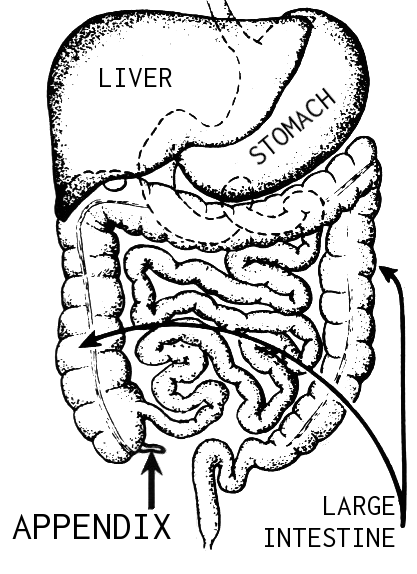
Anyway, our point is that you can often get extra marks on an academic paper by using the appendices effectively. In this blog post, we explain how.
What to Put in the Appendix
An appendix is where extra information goes. What you include, and how many appendices you need, will depend on what you’re writing about. Common examples include:
- Raw test data
- Technical figures, graphs and tables
- Maps, charts and illustrations
- Letters and emails
- Sample questionnaires and surveys
- Interview transcripts
These are all things you might want to reference in your main essay without including them in full. For example, even if you quote an interview in the results and discussion section of an essay, you would not usually include the full transcript. Instead, you would write:
Participant 4 claimed to experience ‘dizziness and nausea’ (see Appendix B).
This points the reader to the appendix if they want to see where the quote came from.
Find this useful?
Subscribe to our newsletter and get writing tips from our editors straight to your inbox.
How to Format Appendices
The correct way to format appendices will depend on your university, so make sure to check your style guide . But in general, the following rules should be followed:
- Place appendices at the end of your document after the reference list
- Divide appendices by topic (e.g. separate sections for test results, illustrations and transcripts)
- Start each appendix on a new page and label it with a letter or number, along with a title clarifying content (Appendix A: Instrument Diagrams, Appendix B: Test Results, etc.)
- List appendices in the table of contents at the beginning of your document
Doing these things will make it easier for your reader to find information in the appendices.
Appendices and the Word Count
Appendices are not usually included in the word count for your paper. This means you can cut non-essential information from the main chapters and add it to an appendix without worrying about exceeding the word limit.
But be warned! This is not an excuse to cut vital information from your work. You must included all important data in your main essay. If you put essential information in the appendices, it could count against you when your work is marked.
Some universities include appendices in the word count, though, so there are better ways to ensure that your work doesn’t end up too wordy!
Share this article:
Post A New Comment
Get help from a language expert. Try our proofreading services for free.
5-minute read
Free Email Newsletter Template
Promoting a brand means sharing valuable insights to connect more deeply with your audience, and...
6-minute read
How to Write a Nonprofit Grant Proposal
If you’re seeking funding to support your charitable endeavors as a nonprofit organization, you’ll need...
9-minute read
How to Use Infographics to Boost Your Presentation
Is your content getting noticed? Capturing and maintaining an audience’s attention is a challenge when...
8-minute read
Why Interactive PDFs Are Better for Engagement
Are you looking to enhance engagement and captivate your audience through your professional documents? Interactive...
7-minute read
Seven Key Strategies for Voice Search Optimization
Voice search optimization is rapidly shaping the digital landscape, requiring content professionals to adapt their...
How to Ace Slack Messaging for Contractors and Freelancers
Effective professional communication is an important skill for contractors and freelancers navigating remote work environments....

Make sure your writing is the best it can be with our expert English proofreading and editing.
Thesis and Dissertation Guide
- « Thesis & Dissertation Resources
- The Graduate School Home
- Introduction
Copyright Page
Dedication, acknowledgements, preface (optional), table of contents.
- List of Tables, Figures, and Illustrations
List of Abbreviations
List of symbols.
- Non-Traditional Formats
- Font Type and Size
- Spacing and Indentation
- Tables, Figures, and Illustrations
- Formatting Previously Published Work
- Internet Distribution
- Open Access
- Registering Copyright
- Using Copyrighted Materials
- Use of Your Own Previously Published Materials
- Submission Steps
- Submission Checklist
- Sample Pages
I. Order and Components
Please see the sample thesis or dissertation pages throughout and at the end of this document for illustrations. The following order is required for components of your thesis or dissertation:
- Dedication, Acknowledgements, and Preface (each optional)
- Table of Contents, with page numbers
- List of Tables, List of Figures, or List of Illustrations, with titles and page numbers (if applicable)
- List of Abbreviations (if applicable)
- List of Symbols (if applicable)
- Introduction, if any
- Main body, with consistent subheadings as appropriate
- Appendices (if applicable)
- Endnotes (if applicable)
- References (see section on References for options)
Many of the components following the title and copyright pages have required headings and formatting guidelines, which are described in the following sections.
Please consult the Sample Pages to compare your document to the requirements. A Checklist is provided to assist you in ensuring your thesis or dissertation meets all formatting guidelines.
The title page of a thesis or dissertation must include the following information:
- The title of the thesis or dissertation in all capital letters and centered 2″ below the top of the page.
- Your name, centered 1″ below the title. Do not include titles, degrees, or identifiers. The name you use here does not need to exactly match the name on your university records, but we recommend considering how you will want your name to appear in professional publications in the future.
Notes on this statement:
- When indicating your degree in the second bracketed space, use the full degree name (i.e., Doctor of Philosophy, not Ph.D. or PHD; Master of Public Health, not M.P.H. or MPH; Master of Social Work, not M.S.W. or MSW).
- List your department, school, or curriculum rather than your subject area or specialty discipline in the third bracketed space. You may include your subject area or specialty discipline in parentheses (i.e., Department of Romance Languages (French); School of Pharmacy (Molecular Pharmaceutics); School of Education (School Psychology); or similar official area).
- If you wish to include both your department and school names, list the school at the end of the statement (i.e., Department of Pharmacology in the School of Medicine).
- A dissertation submitted to the faculty at the University of North Carolina at Chapel Hill in partial fulfillment of the requirements for the degree of Doctor of Philosophy in the Department of Public Policy.
- A thesis submitted to the faculty at the University of North Carolina at Chapel Hill in partial fulfillment of the requirements for the degree of Master of Science in the School of Dentistry (Endodontics).
- A thesis submitted to the faculty at the University of North Carolina at Chapel Hill in partial fulfillment of the requirements for the degree of Master of Science in the Department of Nutrition in the Gillings School of Global Public Health.
- A dissertation submitted to the faculty at the University of North Carolina at Chapel Hill in partial fulfillment of the requirements for the degree of Doctor of Philosophy in the School of Education (Cultural Studies and Literacies).
- The words “Chapel Hill” must be centered 1″ below the statement.
- One single-spaced line below that, center the year in which your committee approves the completed thesis or dissertation. This need not be the year you graduate.
- Approximately 2/3 of the way across the page on the right-hand side of the page, 1″ below the year, include the phrase “Approved by:” (with colon) followed by each faculty member's name on subsequent double-spaced lines. Do not include titles such as Professor, Doctor, Dr., PhD, or any identifiers such as “chair” or “advisor” before or after any names. Line up the first letter of each name on the left under the “A” in the “Approved by:” line. If a name is too long to fit on one line, move this entire section of text slightly to the left so that formatting can be maintained.
- No signatures, signature lines, or page numbers should be included on the title page.
Include a copyright page with the following information single-spaced and centered 2″ above the bottom of the page:
© Year Author's Full Name (as it appears on the title page) ALL RIGHTS RESERVED
This page immediately follows the title page. It should be numbered with the lower case Roman numeral ii centered with a 1/2″ margin from the bottom edge.
Inclusion of this page offers you, as the author, additional protection against copyright infringement as it eliminates any question of authorship and copyright ownership. You do not need to file for copyright in order to include this statement in your thesis or dissertation. However, filing for copyright can offer other protections.
See Section IV for more information on copyrighting your thesis or dissertation.
Include an abstract page following these guidelines:
- Include the heading “ABSTRACT” in all capital letters, and center it 2″ below the top of the page.
- One double-spaced line below “ABSTRACT”, center your name, followed by a colon and the title of the thesis or dissertation. Use as many lines as necessary. Be sure that your name and the title exactly match the name and title used on the Title page.
- One single-spaced line below the title, center the phrase “(Under the direction of [advisor's name])”. Include the phrase in parentheses. Include the first and last name(s) of your advisor or formal co-advisors. Do not include the name of other committee members. Use the advisor's name only; do not include any professional titles such as PhD, Professor, or Dr. or any identifiers such as “chair” or “advisor”.
- Skip one double-spaced line and begin the abstract. The text of your abstract must be double-spaced and aligned with the document's left margin with the exception of indenting new paragraphs. Do not center or right-justify the abstract.
- Abstracts cannot exceed 150 words for a thesis or 350 words for a dissertation.
- Number the abstract page with the lower case Roman numeral iii (and iv, if more than one page) centered with a 1/2″ margin from the bottom edge.
Please write and proofread your abstract carefully. When possible, avoid including symbols or foreign words in your abstract, as they cannot be indexed or searched. Avoid mathematical formulas, diagrams, and other illustrative materials in the abstract. Offer a brief description of your thesis or dissertation and a concise summary of its conclusions. Be sure to describe the subject and focus of your work with clear details and avoid including lengthy explanations or opinions.
Your title and abstract will be used by search engines to help potential audiences locate your work, so clarity will help to draw the attention of your targeted readers.
You have an option to include a dedication, acknowledgements, or preface. If you choose to include any or all of these elements, give each its own page(s).
A dedication is a message from the author prefixed to a work in tribute to a person, group, or cause. Most dedications are short statements of tribute beginning with “To…” such as “To my family”.
Acknowledgements are the author's statement of gratitude to and recognition of the people and institutions that helped the author's research and writing.
A preface is a statement of the author's reasons for undertaking the work and other personal comments that are not directly germane to the materials presented in other sections of the thesis or dissertation. These reasons tend to be of a personal nature.
Any of the pages must be prepared following these guidelines:
- Do not place a heading on the dedication page.
- The text of short dedications must be centered and begin 2″ from the top of the page.
- Headings are required for the “ACKNOWLEDGEMENTS” and “PREFACE” pages. Headings must be in all capital letters and centered 2″ below the top of the page.
- The text of the acknowledgements and preface pages must begin one double-spaced line below the heading, be double-spaced, and be aligned with the document's left margin with the exception of indenting new paragraphs.
- Subsequent pages of text return to the 1″ top margin.
- The page(s) must be numbered with consecutive lower case Roman numerals (starting with the page number after the abstract) centered with a 1/2″ margin from the bottom edge.
Include a table of contents following these guidelines:
- Include the heading “TABLE OF CONTENTS” in all capital letters, and center it 2″ below the top of the page.
- Include one double-spaced line between the heading and the first entry.
- The table of contents should not contain listings for the pages that precede it, but it must list all parts of the thesis or dissertation that follow it.
- If relevant, be sure to list all appendices and a references section in your table of contents. Include page numbers for these items but do not assign separate chapter numbers.
- Entries must align with the document's left margin or be indented to the right of the left page margin using consistent tabs.
- Major subheadings within chapters must be included in the table of contents. The subheading(s) should be indented to the right of the left page margin using consistent tabs.
- If an entry takes up more than one line, break up the entry about three-fourths of the way across the page and place the rest of the text on a second line, single-spacing the two lines.
- Include one double-spaced line between each entry.
- Page numbers listed in the table of contents must be located just inside the right page margin with leaders (lines of periods) filling out the space between the end of the entry and the page number. The last digit of each number must line up on the right margin.
- Information included in the table of contents must match the headings, major subheadings, and numbering used in the body of the thesis or dissertation.
- The Table of Contents page(s) must be numbered with consecutive lower case Roman numerals centered with a 1/2″ margin from the bottom edge.
Lists of Tables, Figures, and Illustrations
If applicable, include a list of tables, list of figures, and/or list of illustrations following these guidelines:
- Include the heading(s) in all capital letters, centered 1″ below the top of the page.
- Each entry must include a number, title, and page number.
- Assign each table, figure, or illustration in your thesis or dissertation an Arabic numeral. You may number consecutively throughout the entire work (e.g., Figure 1, Figure 2, etc.), or you may assign a two-part Arabic numeral with the first number designating the chapter in which it appears, separated by a period, followed by a second number to indicate its consecutive placement in the chapter (e.g., Table 3.2 is the second table in Chapter Three).
- Numerals and titles must align with the document's left margin or be indented to the right of the left page margin using consistent tabs.
- Page numbers must be located just inside the right page margin with leaders (lines of periods) filling out the space between the end of the entry and the page number. The last digit of each number must line up on the right margin.
- Numbers, titles, and page numbers must each match the corresponding numbers, titles, and page numbers appearing in the thesis or dissertation.
- All Lists of Tables, Figures, and Illustrations page(s) must be numbered with consecutive lower case Roman numerals centered with a 1/2″ margin from the bottom edge.
If you use abbreviations extensively in your thesis or dissertation, you must include a list of abbreviations and their corresponding definitions following these guidelines:
- Include the heading “LIST OF ABBREVIATIONS” in all capital letters, and center it 1″ below the top of the page.
- Arrange your abbreviations alphabetically.
- Abbreviations must align with the document's left margin or be indented to the right of the left page margin using consistent tabs.
- If an entry takes up more than one line, single-space between the two lines.
- The List of Abbreviations page(s) must be numbered with consecutive lower case Roman numerals centered with a 1/2″ margin from the bottom edge.
If you use symbols in your thesis or dissertation, you may combine them with your abbreviations, titling the section “LIST OF ABBREVIATIONS AND SYMBOLS”, or you may set up a separate list of symbols and their definitions by following the formatting instructions above for abbreviations. The heading you choose must be in all capital letters and centered 1″ below the top of the page.
Previous: Introduction
Next: Format
- A Guide to Writing a PhD Thesis
Written by Ben Taylor
A PhD thesis is a work of original research all students are requiured to submit in order to succesfully complete their PhD. The thesis details the research that you carried out during the course of your doctoral degree and highlights the outcomes and conclusions reached.
The PhD thesis is the most important part of a doctoral research degree: the culmination of three or four years of full-time work towards producing an original contribution to your academic field.
Your PhD dissertation can therefore seem like quite a daunting possibility, with a hefty word count, the pressure of writing something new and, of course, the prospect of defending it at a viva once you’ve finished.
This page will give you an introduction to what you need to know about the doctoral thesis, with advice on structure, feedback, submission and more.
Pick the right programme for you
There are lots of choices, let us help you to make the right one. Sign up to our weekly newsletter for the latest advice and guidance from our team of experts.
On this page
Beginning your phd thesis.
The first stage of your PhD thesis will usually be the literature review . We’ve already written a detailed guide to what the PhD literature review involves , but here’s what you need to know about this stage of your PhD:
- The literature review is a chance for you to display your knowledge and understanding of what’s already been written about your research area – this could consist of papers, articles, books, data and more
- Rather than simply summarising what other scholars have said about your subject, you should aim to assess and analyse their arguments
- The literature review is usually the first task of your PhD – and typically forms the first part or chapter of your dissertation
After finishing your literature review, you’ll move onto the bulk of your doctoral thesis. Of course, you’ll eventually return to the lit review to make sure it’s up-to-date and contains any additional material you may have come across during the course of your research.
PhD thesis research
What sets your PhD thesis apart from previous university work you’ve done is the fact that it should represent an original contribution to academic knowledge . The form that this original contribution takes will largely depend on your discipline.
- Arts and Humanities dissertations usually involve investigating different texts, sources and theoretical frameworks
- Social Sciences are more likely to focus on qualitive or quantitative surveys and case studies
- STEM subjects involve designing, recording and analysing experiments, using their data to prove or disprove a set theory
Depending on the nature of your research, you may ‘write up’ your findings as you go, or leave it until the dedicated ‘writing-up’ period, usually in the third year of your PhD. Whatever your approach, it’s vital to keep detailed notes of your sources and methods – it’ll make your life a lot easier when it comes to using references in your dissertation further down the line.
PhD thesis vs dissertation
It’s common to use the terms ‘thesis’ and ‘dissertation’ interchangeably, but strictly speaking there is a difference in meaning between them:
- Your thesis is your argument. It’s the conclusions you’ve arrived at through surveying existing scholarship in your literature review and combining this with the results of your own original research.
- Your dissertation is the written statement of your thesis. This is where you lay out your findings in a way that systematically demonstrates and proves your conclusion.
Put simply, you submit a dissertation, but it’s the thesis it attempts to prove that will form the basis of your PhD.
What this also means is that the writing up of your dissertation generally follows the formulation of your doctoral thesis (it’s fairly difficult to write up a PhD before you know what you want to say!).
However, it’s normal for universities and academics to use either (or both) terms when describing PhD research – indeed, we use both ‘thesis’ and ‘dissertation’ across our website.
Can I use my Masters research in my PhD thesis?
If you’re studying an MPhil, it’s normal to ‘ upgrade ’ it into a PhD. Find mroe information on our guide.
PhD thesis structure
Having completed your initial literature review and conducted your original research, you’ll move onto the next phase of your doctoral dissertation, beginning to sketch out a plan that your thesis will follow.
The exact structure and make-up of your doctoral thesis will vary between fields, but this is the general template that many dissertations follow:
- Introduction – This sets out the key objectives of your project, why the work is significant and what its original contribution to knowledge is. At this point you may also summarise the remaining chapters, offering an abstract of the argument you will go on to develop.
- Literature review – The introduction will generally lead into a write-up of your literature review. Here you’ll outline the scholarly context for your project. You’ll acknowledge where existing research has shaped your PhD, but emphasise the unique nature of your work.
- Chapters – After you’ve finished introducing your research, you’ll begin the bulk of the dissertation. This will summarise your results and begin explaining the argument you have based on them. Some PhDs will also include specific chapters on methodology and / or a recreation of the data you have developed. Others will develop your argument over a series of stages, drawing on sources and results as relevant.
- Conclusion – The dissertation will end with a final chapter that pulls together the different elements of your argument and the evidence you have provided for it. You’ll restate the significance of your project (and its all-important original contribution to knowledge). You may also take the opportunity to acknowledge the potential for further work or opportunities to apply your findings outside academia.
- Bibliography and appendices – At the end of your thesis, you’ll need to include a full list of the books, articles and data you’ve referenced in a bibliography. You may also need to provide additional information in the form of an appendix.
How long is a PhD thesis?
The length of a PhD thesis varies from subject to subject, but all are far longer than those for undergraduate or Masters degrees. Your university will usually set an upper limit – typically between 70,000 and 100,000 words, with most dissertations coming in at around 80,000 words.
Generally speaking, STEM-based theses will be a little shorter than those in the Arts, Humanities and Social Sciences.
Different universities (and departments) will have different policies regarding what counts towards the PhD thesis word count, so make sure you’re aware what is expected of you. Check with your supervisor whether references, the bibliography or appendices are included in the word count for your dissertation.
How many chapters should a PhD thesis have?
There’s no hard and fast rule for the numbers of chapters in a PhD thesis, but most will have four or five chapters (in addition to the introduction and conclusion). This is the sort of thing you’ll discuss with your supervisor when planning out your research.
Writing up your PhD thesis
Once you’ve conducted your research and settled upon your thesis, there’s only one thing left to do: get it down on paper. Appropriately enough, this final part of a PhD is often referred to as the ‘ writing up period ’.
This is when you produce the final dissertation, which will be submitted as the basis for your viva voce exam. The nature of this task can vary from PhD to PhD.
In some cases you may already have a large amount of chapter drafts and other material. ‘Writing up’ therefore becomes a process of re-drafting and assembling this work into a final dissertation. This approach is common in Arts and Humanities subjects where PhD students tend to work through stages of a project, writing as they go.
Alternatively, you may have spent most of your PhD collecting and analysing data. If so, you’ll now ‘write up’ your findings and conclusions in order to produce your final dissertation. This approach is more common in STEM subjects, where experiment design and data collection are much more resource intensive.
Whatever process you adopt, you’ll now produce a persuasive and coherent statement of your argument, ready to submit for examination.
PhD thesis feedback
Your supervisor will usually give you feedback on each chapter draft, and then feedback on the overall completed dissertation draft before you submit it for examination. When the thesis is a work-in-progress, their comments will be a chance for them to make sure your research is going in the right direction and for you to ask their advice on anything you’re concerned about. This feedback will normally be given in the form of a supervisory meeting.
Although your PhD supervisor will be happy to give you advice on your work, you shouldn’t expect them to be an editor – it’s not their responsibility to correct grammatical or spelling mistakes, and you should make sure any drafts you submit to them are as error-free as possible. Similarly, they won’t be willing to edit your work down to fit a particular word count.
Finishing your PhD thesis
When you’ve finished the final draft of your doctoral thesis and it’s been approved by your supervisor, you’ll submit it for examination. This is when it’s sent to the examiners who will conduct your viva.
Submitting your thesis involves printing enough copies for your examiners and the university’s repository. Don’t leave this until the last minute – printing multiple copies of a 300-page document is a substantial undertaking and you should always allow enough time to account for any possible glitches or issues with the printing process.
Your viva will usually take place within three months of submitting your thesis. You can find out more in our dedicated guide to the PhD viva . After your viva, your examiners will give you a report that confirms whether or not you need to make any changes to your thesis, with several different potential outcomes:
- Pass – You’ve received your doctoral qualification!
- Minor corrections – These are usually fairly small edits, tweaks and improvements to your thesis, which you’ll be given three months to implement
- Major corrections – For these substantial changes, you may have to rewrite part of your dissertation or complete extra research, with a six-month deadline
Most PhD students will need to fix some corrections with their thesis (hopefully not major ones). It’s very rare for a dissertation to be failed.
Once you’ve made any necessary changes to your thesis, you’ll submit it one last time (usually electronically).
If you have plans to publish all or part of your work, you may want to request an embargo so that it won’t be visible to the public for a certain time. 12 months is a fairly standard time period for this, although you may want to ask for a longer embargo if you know that you want to turn your thesis into a book or monograph.
Take a look at our programme listings and find the perfect PhD for you.
Our postgrad newsletter shares courses, funding news, stories and advice
Ben worked in the FindAPhD content team from 2017 to 2022, starting as an Assistant Content Writer and leaving as Student Content Manager. He focused on producing well-researched advice across a range of topics related to postgraduate study. Ben has a Bachelors degree in English Literature from the University of Sheffield and a Masters from the University of Amsterdam. Having also spent a semester at the University of Helsinki through the Erasmus programme, he’s no stranger to study abroad (or cold weather!).
You may also like...

The PhD is the most common variety of doctorate, but others are awarded in specific disciplines or sometimes particular countries.

Joint PhD programmes involve collaboration between two (or more) different universities. So how does that work? Who can apply? And what are the advantages (and disadvantages) of researching in this way?

Integrated PhD programmes consist of a one-year Masters followed by three years of PhD research. Find out more about what it's like to study an integrated PhD, how to apply and the funding options available.

Thinking of applying for the Doctor of Engineering (EngD)? Our guide covers everything you need to know about the qualification, including costs, applications, programme content, and how it differs from a PhD.

A PhD isn't the only option for postgraduate researchers. Our guides explain professional doctorates, joint degrees and compare other qualification types.

How does the value of an MPhil compare with a PhD, and why might you choose the Masters over the doctorate?
FindAPhD. Copyright 2005-2024 All rights reserved.
Unknown ( change )
Have you got time to answer some quick questions about PhD study?
Select your nearest city
You haven’t completed your profile yet. To get the most out of FindAPhD, finish your profile and receive these benefits:
- Monthly chance to win one of ten £10 Amazon vouchers ; winners will be notified every month.*
- The latest PhD projects delivered straight to your inbox
- Access to our £6,000 scholarship competition
- Weekly newsletter with funding opportunities, research proposal tips and much more
- Early access to our physical and virtual postgraduate study fairs
Or begin browsing FindAPhD.com
or begin browsing FindAPhD.com
*Offer only available for the duration of your active subscription, and subject to change. You MUST claim your prize within 72 hours, if not we will redraw.

Create your account
Looking to list your PhD opportunities? Log in here .
- How it works

What is Appendix in the Dissertation?
Published by Alvin Nicolas at August 12th, 2021 , Revised On June 13, 2023
“Appendix or appendices (plural) is/are used to provide additional data related to your dissertation research project.”
An appendix section in dissertation helps you to provide background data related to your topic; present tables, illustrations, and figures that are not directly relevant to your research questions in order to avoid disrupting the flow of the text; to make sure that your dissertation paper’s word count does not go beyond the limit. This article explains what is an appendix in the dissertation.
The Purpose of an Appendix
The main body of the dissertation paper generally contains text that adds weight to your arguments. However, some information that is not directly relevant to the topic of research but might be useful to your audience could be provided under the appendices section.
Any additional information that does not directly support your in-text arguments goes into appendices. This helps to keep your paper organised and within the word limit. It is important to make sure that your readers can understand the contents of your dissertation paper without having to look at the appendices. Any information that is important should be mentioned in the main body.
Items Included in Appendices in Dissertation
An appendix, which is also known as a postscript, includes the following:
Research findings can be presented in several ways. Findings including tables, illustrations and figures that are directly relevant to your research questions or research problem are included in the main body.
However, there are certain text, tables and figures —such as supplemental analyses—that really need to be shown and cannot be ignored, but (due to less significance) can’t be included in the main body as it can disturb the flow of the text.
Such tables and figures are then included in the appendix section. The appendix includes more of the illustrations and findings as a result of data analysis that doesn’t directly address the research question but are essential to be shown.
Also Read: How to Write Dissertation Acknowledgements
Surveys/Interviews
Appendices are helpful in mentioning extra information related to surveys , interviews or focus groups. You can clearly mention how respondents responded to underpin your findings.
Include Abbreviations Section
If you have utilised a lot of abbreviations or jargon, it might be difficult for lay-person to understand those terms. You can include the abbreviations section or a glossary section in the appendix, which are sometimes positioned at the start of the dissertation.
Tables, Figures and/or Graphs
Your dissertation may include a lot of tables, figures and/or graphs due to the nature of research . The appendix is the appropriate platform to include all this information, including illustrations.
Looking for dissertation help?
Researchprospect to the rescue, then.
We have expert writers on our team who are skilled at helping students with quantitative dissertations across a variety of disciplines. Guaranteeing 100% satisfaction!


Appendix Format
You can carry on with just one long appendix (if you don’t want to break it into different components and want it to be the only appendix in your dissertation).
On the other hand, you might want to have separate sections in appendices such as questionnaire responses, findings, key phrases and key terms; it would be easier to figure out the information provided in appendices.
If you decide to include multiple sections within your appendices, each appendix should start on a new page with a clearly assigned title and number, for instance, ‘Appendix 7. Survey questions’ . It allows for each section of the appendix to be clearly visible to the reader and researcher.
It is also recommended to mention the number and title against each element that is directly linked to the appendix so that the reader will be able to know what you are referring to in the main body.
While numbering tables and figures, make sure that you re-start the numbering for each appendix. This means that each table and figure in a new appendix would be titled Table 1 or Figure 1.
Referring to the Appendix in the Main Body of the Dissertation
It is recommended to indicate all appendices at least once in the main body of your dissertation. Make sure that you mention the appendix number (enclosed in brackets, called parenthetical reference ) or within text in the main body (called descriptive reference ) as highlights for the readers.
It is not mandatory to capitalise it as that typically depends on the researcher’s will. You can also refer to certain elements within the appendix (which can be a specific illustration or table).
Example #1. When you are referring to an entire appendix
The focus-group interview (see Appendix 1) shows that… Appendix 2 describes how we gathered data from the sample population….
Example #2. While you are referring to an appendix component
These findings (see Appendix 1, Table 2) show that… Table 2 in Appendix 1 describes the factors which result in the increase in sales.
It would be a good practice to mention Appendix in upper-case, especially when referring to a specific component. However, this is not compulsory and you can choose to use lower-case, i.e., ‘The appendices provided at the end of the documents contain relevant content about the questionnaire responses.’
Here are some more appendix examples for you .
Which is More Appropriate: Appendices or Appendixes?
Both of these words (spellings) are true in their sense and can be used, but appendices is more appropriate according to APA style. However, it is important to ensure consistency throughout the thesis document. Don’t use alternative words in different sections of the dissertation .
Where to Include Appendices?
The general idea in this regard is to include appendices after the main body, i.e., the reference section. If you opt for this option, you need to continue with the same page number format. You can also submit appendices as a separate document with your dissertation project.
You should write down appendices (including titles and page numbers) in the table of contents.
Even if you are still unsure about what an appendix in a dissertation is, our writers can help with this chapter of your paper. All you have to do is complete our online order form , select the dissertation part/chapter as the required service type, attach your dissertation draft, and let us know your deadline. We guarantee that the writer we will assign to your order will have the expertise and qualification to create the appendices to your exact requirements.
FAQs About Appendices in Dissertation
What should i not include in a dissertation appendix.
Don’t include any irrelevant and/or vague information. It will only distract your readers from understanding your study’s overall purpose, significance, etc.
What can I include in an appendix?
You can include in it things like figures and/tables that are too lengthy to be included within the dissertation ; maps, photographs, raw data like participant score lists, computer programs like SPSS, musical examples like audios etc., interview questions and/or sample questionnaires, etc.
Can I include web URLs in an appendix?
Not really, although you can include PDF documents or weblinks to such documents within your dissertation appendix.
You May Also Like
Do dissertations scare you? Struggling with writing a flawless dissertation? Well, congratulations, you have landed in the perfect place. In this blog, we will take you through the detailed process of writing a dissertation. Sounds fun? We thought so!
Make sure to develop a conceptual framework before conducting research. Here is all you need to know about what is a conceptual framework is in a dissertation?
Here are the steps to make a theoretical framework for dissertation. You can define, discuss and evaluate theories relevant to the research problem.
USEFUL LINKS
LEARNING RESOURCES

COMPANY DETAILS

- How It Works
- Deutschland
- United Kingdom

- Revisión en inglés
- Relecture en anglais
- Revisão em inglês
Manuscript Editing
- Research Paper Editing
- Lektorat Doktorarbeit
- Dissertation Proofreading
- Englisches Lektorat
- Journal Manuscript Editing
- Scientific Manuscript Editing Services
- Book Manuscript Editing
- PhD Thesis Proofreading Services
- Wissenschaftslektorat
- Korektura anglického textu
- Akademisches Lektorat
- Journal Article Editing
- Manuscript Editing Services
PhD Thesis Editing
- Medical Editing Sciences
- Proofreading Rates UK
- Medical Proofreading
- PhD Proofreading
- Academic Proofreading
- PhD Proofreaders
- Best Dissertation Proofreaders
- Masters Dissertation Proofreading
- Proofreading PhD Thesis Price
- PhD Dissertation Editing
- Lektorat Englisch Preise
- Lektorieren Englisch
- Wissenschaftliches Lektorat
- Thesis Proofreading Services
- PhD Thesis Proofreading
- Proofreading Thesis Cost
- Proofreading Thesis
- Thesis Editing Services
- Professional Thesis Editing
- PhD Thesis Editing Services
- Thesis Editing Cost
- Dissertation Proofreading Services
- Proofreading Dissertation
PhD Dissertation Proofreading
- Dissertation Proofreading Cost
- Dissertation Proofreader
- Correção de Artigos Científicos
- Correção de Trabalhos Academicos
- Serviços de Correção de Inglês
- Correção de Dissertação
- Correção de Textos Precos
- Revision en Ingles
- Revision de Textos en Ingles
- Revision de Tesis
- Revision Medica en Ingles
- Revision de Tesis Precio
- Revisão de Artigos Científicos
- Revisão de Trabalhos Academicos
- Serviços de Revisão de Inglês
- Revisão de Dissertação
- Revisão de Textos Precos
- Corrección de Textos en Ingles
- Corrección de Tesis
- Corrección de Tesis Precio
- Corrección Medica en Ingles
- Corrector ingles
- Choosing the right Journal
- Journal Editor’s Feedback
- Dealing with Rejection
- Quantitative Research Examples
- Number of scientific papers published per year
- Acknowledgements Example
- ISO, ANSI, CFR & Other
- Types of Peer Review
- Withdrawing a Paper
- What is a good h-index
- Appendix paper
- Cover Letter Templates
- Writing an Article
- How To Write the Findings
- Abbreviations: ‘Ibid.’ & ‘Id.’
- Sample letter to editor for publication
- Tables and figures in research paper
- Journal Metrics
- Revision Process of Journal Publishing
- JOURNAL GUIDELINES
Select Page
Appendices, References, Acknowledgements and Other Final Things
Posted by Rene Tetzner | Oct 22, 2021 | PhD Success | 0 |

4.6 Appendices, References, Acknowledgements and Other Final Things
4.6.1 Appendices
As I mentioned in Sections 1.4.1 and 3.5.3, appendices are not required in a thesis, but they are often included. If you are considering appendices for your thesis, check your university or department guidelines or discuss the idea with your supervisor to be certain that they will be received positively. It is also a good idea to revisit at this point any length or word count requirements or limitations set for doctoral theses by your university or department, because if you have already reached the upper limit, including appendices may require cutting other material, and in such situations appendices should only be considered if they are absolutely necessary. However, appendices are often preferable to extensive or overly long footnotes or endnotes or too much supplementary information in the main text of a thesis, both of which can distract readers from your main argument. For this reason, an effective strategy may be to move such material from the main text or notes into an appendix, since this sort of revision will not significantly alter the overall length or word count of your thesis. If, on the other hand, your thesis is a little shy of the minimum length requirement, you may want to add an appendix or two for supplementary information that you originally cut out of the thesis, but that could usefully be included: this can help you increase the word count to meet requirements. Your decision regarding the inclusion of appendices may also be simplified by the following information and advice.
As a general rule, appendices present subsidiary or supplementary material that is directly related to the material in the thesis itself and potentially helpful to readers, but which might prove distracting or inappropriate or simply too long were it included in the main body of the thesis or in notes (long footnotes in particular can make the layout of pages unattractive and should be avoided). An appendix is also a good format for material that is mentioned or discussed in more than one chapter, part or section of a thesis, because it helps the author avoid repetition while rendering the information readily available to readers. Appendices can contain a wide variety of material, such as texts discussed in the thesis, translations, chronologies, genealogies, examples of principles and procedures, descriptions of complex pieces of equipment, survey questionnaires, participant responses, detailed demographics for a population or sample, lists (particularly long ones), tables and figures, explanations or elaborations of any aspect of a study and any other supplementary information relevant to a thesis.

This material should not be included in an appendix simply because it is interesting and you happen to have it, however; instead, appendices should be included ‘only if they help readers to understand, evaluate, or replicate the study or theoretical argument being made’ ( Publication Manual of the APA , 2010, p.40). An appendix ‘should not be a repository for odds and ends that the author could not work into the text’ ( Chicago Manual of Style , 2003, p.27). Ideally, each appendix should have a specific theme, focus or function and gather materials of a particular type or relating to a particular topic, and it should bear a main heading that describes its content (e.g., ‘Appendix: Questionnaire 3 in Spanish and English’). If more than one theme or topic requires this sort of treatment, additional appendices should be preferred to subdividing a single long appendix, although appendices can certainly make use of internal headings and subheadings if necessary (on headings, see Section 6.1).

It is also best if appendices, like tables and figures, are able to stand on their own, so all abbreviations, symbols and specialised or technical terminology should be briefly defined or explained within each appendix, enabling the reader to understand the material without recourse to definitions and explanations in the rest of the thesis. All information in appendices that overlaps material in the main body of a thesis should match that material precisely in both content and format. Appendices can be set in the font size used in the main body of a thesis or a slightly smaller font to save space and they normally appear in the final matter before the endnotes (if there are any) or before the reference list or bibliography, although in some cases the appendices will be the last items in a thesis, so do check guidelines to determine if a specific position is required. The first appendix in a thesis usually begins on a new page, and subsequent appendices sometimes do the same, though they can run on instead with a little extra spacing between the end of one appendix and the beginning of the next. If there is only one appendix in a thesis, it will not need to be identified by a particular number or letter, but if you intend to include two or more appendices, they will need to be labelled with uppercase letters or with Arabic or Roman numerals according to the order in which the appendices are mentioned in the main text of the thesis, which should match the order of their appearance in the final matter (‘Appendix A,’ ‘Appendix B,’ ‘Appendix C’ etc., or ‘Appendix 1,’ ‘Appendix 2,’ ‘Appendix 3’ etc.). Appendices should always be referred to by these labels when they are discussed in the thesis, and each appendix should be referred to at least briefly in the main text of the thesis.

If a single table or figure makes up the whole of an appendix, the appendix label and heading are sufficient for the table or figure as well, but if an appendix contains more than a single table or figure, each table and figure will need to be numbered (and given a heading or caption), and this numbering should be separate from the tables and figures associated with the chapters of the thesis. If there is only one appendix, a capital A (for ‘Appendix’) should be used before each table or figure number – ‘Table A.1’ and ‘Figure A.2’ – but if more than one appendix is included, the specific letter or number of the appendix should be used as well as the table or figure number: ‘Table C.3,’ ‘Figure B.2,’ ‘Table II.4’ and ‘Figure IV.2.’ Please note that if you have more than one appendix in your thesis and any of those appendices contain more than one table or figure, the appendices should be labelled with letters or Roman numerals; if such appendices use Arabic numerals, it will be difficult to distinguish between tables and figures in chapters and those in the appendices (e.g., ‘Table 3.3’ could be the third table in Chapter 3 or the third table in Appendix 3, whereas ‘Table C.3’ is clearly the third table in Appendix C). Tables and figures may be embedded in appendices that also include text or they may appear at the end of each appendix, but if the university or department guidelines you are following indicate that tables and figures in general should be placed at the end of the thesis, those associated with appendices may need to appear there as well. For further information on tables and figures, see Sections 1.3 and 4.4.1.
4.6.2 Other Final Things
If you have not yet added (or revised and expanded since your proposal) any footnotes or endnotes that you intend to use for supplementary information in the thesis, now is the time to add them (see Section 3.4 above). It can be helpful to construct (or review) the supplementary notes and any appendices you plan to include at the same time so that you can decide which format is most appropriate for different kinds of material. If any ancillary lists are required – a list of abbreviations, for instance, or lists of tables and figures – these should be added at this point as well, either in the preliminary or final matter depending on university or department guidelines and/or personal preferences (see Sections 1.1.7–1.1.9). A list of abbreviations is usually arranged alphabetically by the abbreviations (rather than the full versions) with a colon between each abbreviation and its definition (see also Section 6.3):
ANOVA: Analysis of variance
CI: Confidence interval
ES: Effect size
Lists of tables and figures (on which, see also Sections 1.1.8 and 1.1.9), on the other hand, are arranged numerically according to the table or figure numbers and usually include the page number each table or figure appears on:
Table 1: Items in Questionnaire 1 . . . . . . . . 67
Table 2: Items in Questionnaire 2 . . . . . . . . 71
Table 3: Items in Questionnaire 3 . . . . . . . . 74
Tables are usually listed separately from figures, and shortened forms of table headings and figure captions are often used in these lists, especially if the headings and captions are long (consisting of more than a single sentence, for instance), but the table and figure numbers must match exactly the labels that appear on the tables and figures themselves and the order in which the tables and figures appear in the thesis. When tables and figures are reproduced or adapted from other sources, acknowledgements of those sources are sometimes included in such lists. For general advice on constructing lists, see Section 5.5.2.
Acknowledgements of any assistance you received in writing the thesis and in some cases of any materials you used from previous publications should be added to the thesis as well (see Section 1.1.6). Acknowledgements generally appear in the front matter of a thesis, but they can instead be added to the final matter, so you will need to determine which location is most appropriate for your thesis. Credits and permissions (if necessary) for material such as images, tables and long quotations borrowed from sources sometimes appear along with the borrowed material itself instead of (or in addition to) appearing in the acknowledgements (see Section 4.4.1, for instance). Acknowledgements in theses tend to be rather informal and sometimes intensely personal when compared with the formal scholarly text used in the rest of a thesis. As a general rule, this is fine – you have, after all, had a great deal of help in achieving the monumental goal of writing your thesis and it is only natural to want to thank with enthusiasm those who assisted you. Do beware, however, of letting your prose style slip beneath the required standard.
The acknowledgements may not be part of the scholarship in your thesis, but they are there for all to read, and a thesis is a professional document, so it is wise to maintain a professional perspective. Try to avoid arbitrary shifts between the first-, second- and third-person voices (e.g., ‘I would like to thank my friend and colleague Vicky for reading each and every chapter with such painstaking care – I wouldn’t have survived this thesis without you!’) and informal usage (contractions, for instance, such as ‘wouldn’t’ in my example, the second part of which would be better as ‘– I would not have survived this thesis without her!’). Keep in mind as well that some supervisors and committee members will feel embarrassed and uncomfortable when reading overly effusive expressions of gratitude aimed at themselves – yes, they have been wonderful, but supervising your work is their job, after all – so maintaining the dignity and comfort of everyone involved, including yourself, while expressing sincere and even enthusiastic gratitude is the best approach. Focussing precisely on exactly what each individual has done that specifically assisted you in completing your thesis will help you keep your acknowledgements relevant and professional.
Any dedication you wish to include in the thesis should be added to the front matter at this point as well. More importantly, if you have not yet written your abstract and chosen your keywords, they will need to be tackled, and if you have already worked on these earlier, revising them right after you have finished drafting the entire thesis is a good strategy (see Sections 1.1.2, 1.1.3 and 4.2). Finally, you will need to add or complete all the necessary citations, quotations and references in your thesis and compile the list of references, list of works cited or bibliography that should appear at the end of the thesis (or expand the one you submitted with your proposal: see Sections 1.2.6, 1.4.3, 2.1.2 and 3.5.4). It is very late in the game indeed to be deciding upon referencing methods and styles at this point, but if that is not yet a settled matter, a consistent and effective system must be adopted and applied throughout the thesis before it is considered a complete draft, and it is always wise to check your references carefully to be sure you have met the requirements set by your university, department and thesis committee. In Chapter 7 below I discuss in detail the main methods and styles of in-text referencing as well as reference lists and bibliographies, so please refer to that chapter for specific advice on bringing your references into line with scholarly standards, especially if you do not have specific guidelines to follow. If you use direct quotations in your thesis, see also Chapter 8, where I outline the ways in which direct quotations should be presented and integrated in academic and scientific prose.
Finally, once you have the entire thesis drafted, your table of contents will need to be completed by adding page numbers for the parts, chapters and sections of the thesis (and perhaps removing the summaries you used for your thesis outline if you have not already done so: see Section 4.1), or updated and checked if you are making use of a tool such as Word’s automatic table of contents function (see Section 6.1.1 for advice on creating an active table of contents). Make sure that all page numbers in the table of contents accurately indicate the pages on which those parts, chapters and sections actually appear in the thesis, and check the table of contents carefully to ensure that all titles and headings that appear in it match the corresponding headings in the thesis exactly in terms of order, wording, numbering (if used), punctuation and usually capitalisation as well (see Section 6.1 for further information on headings). Even something as simple as line spacing is important in this final stage. Although you may have single spaced your writing while sharing it with your supervisor and the other members of your committee without earning any complaints, double spacing is usual in the main body or running text of a thesis and it also tends to make your work more legible and easier on the eyes of your readers than single spacing does. Many universities will require double spacing, so do check for that in the guidelines and perhaps pay your readers (who are also your examiners) the courtesy of using it even if it is not required.
Why PhD Success?
To Graduate Successfully
This article is part of a book called "PhD Success" which focuses on the writing process of a phd thesis, with its aim being to provide sound practices and principles for reporting and formatting in text the methods, results and discussion of even the most innovative and unique research in ways that are clear, correct, professional and persuasive.

The assumption of the book is that the doctoral candidate reading it is both eager to write and more than capable of doing so, but nonetheless requires information and guidance on exactly what he or she should be writing and how best to approach the task. The basic components of a doctoral thesis are outlined and described, as are the elements of complete and accurate scholarly references, and detailed descriptions of writing practices are clarified through the use of numerous examples.

The basic components of a doctoral thesis are outlined and described, as are the elements of complete and accurate scholarly references, and detailed descriptions of writing practices are clarified through the use of numerous examples. PhD Success provides guidance for students familiar with English and the procedures of English universities, but it also acknowledges that many theses in the English language are now written by candidates whose first language is not English, so it carefully explains the scholarly styles, conventions and standards expected of a successful doctoral thesis in the English language.

Individual chapters of this book address reflective and critical writing early in the thesis process; working successfully with thesis supervisors and benefiting from commentary and criticism; drafting and revising effective thesis chapters and developing an academic or scientific argument; writing and formatting a thesis in clear and correct scholarly English; citing, quoting and documenting sources thoroughly and accurately; and preparing for and excelling in thesis meetings and examinations.

Completing a doctoral thesis successfully requires long and penetrating thought, intellectual rigour and creativity, original research and sound methods (whether established or innovative), precision in recording detail and a wide-ranging thoroughness, as much perseverance and mental toughness as insight and brilliance, and, no matter how many helpful writing guides are consulted, a great deal of hard work over a significant period of time. Writing a thesis can be an enjoyable as well as a challenging experience, however, and even if it is not always so, the personal and professional rewards of achieving such an enormous goal are considerable, as all doctoral candidates no doubt realise, and will last a great deal longer than any problems that may be encountered during the process.
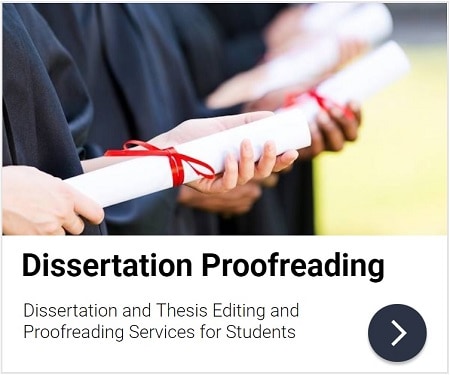
Interested in Proofreading your PhD Thesis? Get in Touch with us
If you are interested in proofreading your PhD thesis or dissertation, please explore our expert dissertation proofreading services.

Rene Tetzner
Rene Tetzner's blog posts dedicated to academic writing. Although the focus is on How To Write a Doctoral Thesis, many other important aspects of research-based writing, editing and publishing are addressed in helpful detail.
Related Posts

PhD Success – How To Write a Doctoral Thesis
October 1, 2021

Table of Contents – PhD Success
October 2, 2021

The Essential – Preliminary Matter
October 3, 2021

The Main Body of the Thesis
October 4, 2021
Have a language expert improve your writing
Run a free plagiarism check in 10 minutes, automatically generate references for free.
- Knowledge Base
- Dissertation
- Research Paper Appendix | Example & Templates
Research Paper Appendix | Example & Templates
Published on 15 August 2022 by Kirsten Dingemanse and Tegan George. Revised on 25 October 2022.
An appendix is a supplementary document that facilitates your reader’s understanding of your research but is not essential to your core argument. Appendices are a useful tool for providing additional information or clarification in a research paper , dissertation , or thesis without making your final product too long.
Appendices help you provide more background information and nuance about your topic without disrupting your text with too many tables and figures or other distracting elements.
We’ve prepared some examples and templates for you, for inclusions such as research protocols, survey questions, and interview transcripts. All are worthy additions to an appendix. You can download these in the format of your choice below.
Download Word doc Download Google doc
Instantly correct all language mistakes in your text
Be assured that you'll submit flawless writing. Upload your document to correct all your mistakes.

Table of contents
What is an appendix in a research paper, what to include in an appendix, how to format an appendix, how to refer to an appendix, where to put your appendices, other components to consider, appendix checklist.
In the main body of your research paper, it’s important to provide clear and concise information that supports your argument and conclusions . However, after doing all that research, you’ll often find that you have a lot of other interesting information that you want to share with your reader.
While including it all in the body would make your paper too long and unwieldy, this is exactly what an appendix is for.
As a rule of thumb, any detailed information that is not immediately needed to make your point can go in an appendix. This helps to keep your main text focused but still allows you to include the information you want to include somewhere in your paper.
Prevent plagiarism, run a free check.
An appendix can be used for different types of information, such as:
- Supplementary results : Research findings are often presented in different ways, but they don’t all need to go in your paper. The results most relevant to your research question should always appear in the main text, while less significant results (such as detailed descriptions of your sample or supplemental analyses that do not help answer your main question), can be put in an appendix.
- Statistical analyses : If you conducted statistical tests using software like Stata or R, you may also want to include the outputs of your analysis in an appendix.
- Further information on surveys or interviews : Written materials or transcripts related to things such as surveys and interviews can also be placed in an appendix.
You can opt to have one long appendix, but separating components (like interview transcripts, supplementary results, or surveys) into different appendices makes the information simpler to navigate.
Here are a few tips to keep in mind:
- Always start each appendix on a new page.
- Assign it both a number (or letter) and a clear title, such as ‘Appendix A. Interview transcripts’. This makes it easier for your reader to find the appendix, as well as for you to refer back to it in your main text.
- Number and title the individual elements within each appendix (e.g., ‘Transcripts’) to make it clear what you are referring to. Restart the numbering in each appendix at 1.
It is important that you refer to each of your appendices at least once in the main body of your paper. This can be done by mentioning the appendix and its number or letter, either in parentheses or within the main part of a sentence. It is also possible to refer to a particular component of an appendix.
Appendix B presents the correspondence exchanged with the fitness boutique. Example 2. Referring to an appendix component These results (see Appendix 2, Table 1) show that …
It is common to capitalise ‘Appendix’ when referring to a specific appendix, but it is not mandatory. The key is just to make sure that you are consistent throughout your entire paper, similarly to consistency in capitalising headings and titles in academic writing.
However, note that lowercase should always be used if you are referring to appendices in general. For instance, ‘The appendices to this paper include additional information about both the survey and the interviews.’
The simplest option is to add your appendices after the main body of your text, after you finish citing your sources in the citation style of your choice . If this is what you choose to do, simply continue with the next page number. Another option is to put the appendices in a separate document that is delivered with your dissertation.
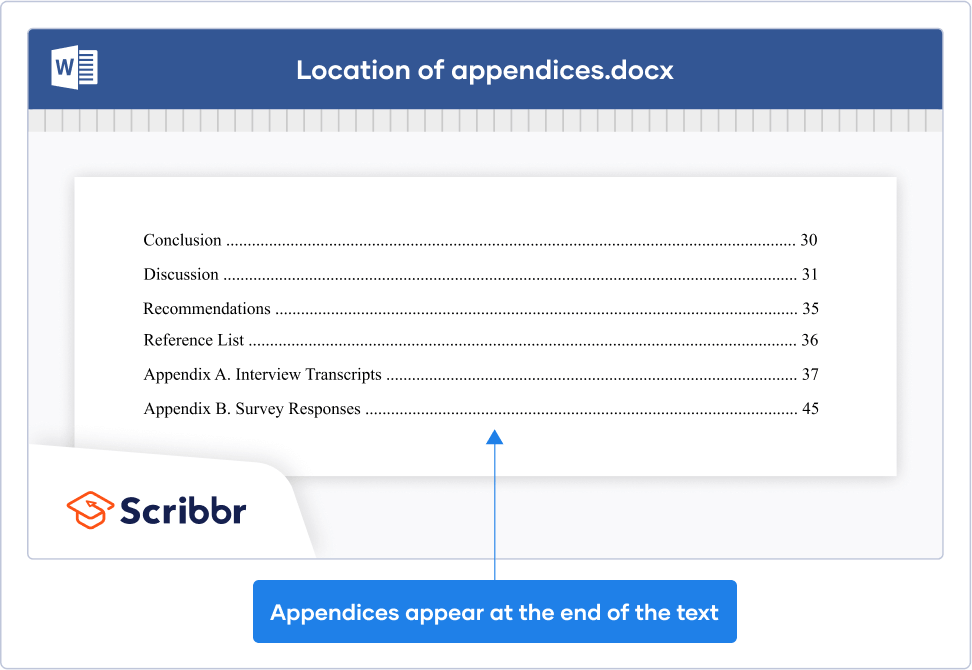
Remember that any appendices should be listed in your paper’s table of contents .
There are a few other supplementary components related to appendices that you may want to consider. These include:
- List of abbreviations : If you use a lot of abbreviations or field-specific symbols in your dissertation, it can be helpful to create a list of abbreviations .
- Glossary : If you utilise many specialised or technical terms, it can also be helpful to create a glossary .
- Tables, figures and other graphics : You may find you have too many tables, figures, and other graphics (such as charts and illustrations) to include in the main body of your dissertation. If this is the case, consider adding a figure and table list .
Checklist: Appendix
All appendices contain information that is relevant, but not essential, to the main text.
Each appendix starts on a new page.
I have given each appendix a number and clear title.
I have assigned any specific sub-components (e.g., tables and figures) their own numbers and titles.
My appendices are easy to follow and clearly formatted.
I have referred to each appendix at least once in the main text.
Your appendices look great! Use the other checklists to further improve your thesis.
Cite this Scribbr article
If you want to cite this source, you can copy and paste the citation or click the ‘Cite this Scribbr article’ button to automatically add the citation to our free Reference Generator.
Dingemanse, K. & George, T. (2022, October 25). Research Paper Appendix | Example & Templates. Scribbr. Retrieved 14 October 2024, from https://www.scribbr.co.uk/thesis-dissertation/appendix/
Is this article helpful?
Kirsten Dingemanse
Other students also liked, thesis & dissertation acknowledgements | tips & examples, dissertation title page, how to write a results section | tips & examples.

Dissertation Structure & Layout 101:

In this post, we’ll be discussing a traditional dissertation/thesis structure and layout, which is generally used for social science research across universities, whether in the US, UK, Europe or Australia. However, some universities may have small variations on this structure (extra chapters, merged chapters, slightly different ordering, etc).
So, always check with your university if they have a prescribed structure or layout that they expect you to work with. If not, it’s safe to assume the structure we’ll discuss here is suitable. And even if they do have a prescribed structure, you’ll still get value from this post as we’ll explain the core contents of each section.
Overview: S tructuring a dissertation or thesis
- Acknowledgements page
- Abstract (or executive summary)
- Table of contents , list of figures and tables
- Chapter 1: Introduction
- Chapter 2: Literature review
- Chapter 3: Methodology
- Chapter 4: Results
- Chapter 5: Discussion
- Chapter 6: Conclusion
- Reference list
As I mentioned, some universities will have slight variations on this structure. For example, they want an additional “personal reflection chapter”, or they might prefer the results and discussion chapter to be merged into one. Regardless, the overarching flow will always be the same, as this flow reflects the research process , which we discussed here – i.e.:
- The introduction chapter presents the core research question and aims .
- The literature review chapter assesses what the current research says about this question.
- The methodology, results and discussion chapters go about undertaking new research about this question.
- The conclusion chapter (attempts to) answer the core research question .
In other words, the dissertation structure and layout reflect the research process of asking a well-defined question(s), investigating, and then answering the question – see below.

To restate that – the structure and layout of a dissertation reflect the flow of the overall research process . This is essential to understand, as each chapter will make a lot more sense if you “get” this concept. If you’re not familiar with the research process, read this post before going further.
Right. Now that we’ve covered the big picture, let’s dive a little deeper into the details of each section and chapter. Oh and by the way, you can also grab our free dissertation/thesis template here to help speed things up.
The title page of your dissertation is the very first impression the marker will get of your work, so it pays to invest some time thinking about your title. But what makes for a good title? A strong title needs to be 3 things:
- Succinct (not overly lengthy or verbose)
- Specific (not vague or ambiguous)
- Representative of the research you’re undertaking (clearly linked to your research questions)
Typically, a good title includes mention of the following:
- The broader area of the research (i.e. the overarching topic)
- The specific focus of your research (i.e. your specific context)
- Indication of research design (e.g. quantitative , qualitative , or mixed methods ).
For example:
A quantitative investigation [research design] into the antecedents of organisational trust [broader area] in the UK retail forex trading market [specific context/area of focus].
Again, some universities may have specific requirements regarding the format and structure of the title, so it’s worth double-checking expectations with your institution (if there’s no mention in the brief or study material).
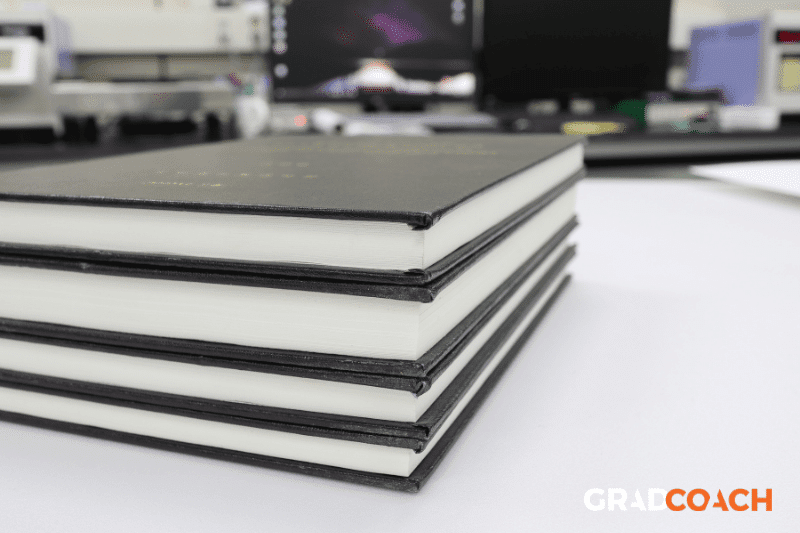
Acknowledgements
This page provides you with an opportunity to say thank you to those who helped you along your research journey. Generally, it’s optional (and won’t count towards your marks), but it is academic best practice to include this.
So, who do you say thanks to? Well, there’s no prescribed requirements, but it’s common to mention the following people:
- Your dissertation supervisor or committee.
- Any professors, lecturers or academics that helped you understand the topic or methodologies.
- Any tutors, mentors or advisors.
- Your family and friends, especially spouse (for adult learners studying part-time).
There’s no need for lengthy rambling. Just state who you’re thankful to and for what (e.g. thank you to my supervisor, John Doe, for his endless patience and attentiveness) – be sincere. In terms of length, you should keep this to a page or less.
Abstract or executive summary
The dissertation abstract (or executive summary for some degrees) serves to provide the first-time reader (and marker or moderator) with a big-picture view of your research project. It should give them an understanding of the key insights and findings from the research, without them needing to read the rest of the report – in other words, it should be able to stand alone .
For it to stand alone, your abstract should cover the following key points (at a minimum):
- Your research questions and aims – what key question(s) did your research aim to answer?
- Your methodology – how did you go about investigating the topic and finding answers to your research question(s)?
- Your findings – following your own research, what did do you discover?
- Your conclusions – based on your findings, what conclusions did you draw? What answers did you find to your research question(s)?
So, in much the same way the dissertation structure mimics the research process, your abstract or executive summary should reflect the research process, from the initial stage of asking the original question to the final stage of answering that question.
In practical terms, it’s a good idea to write this section up last , once all your core chapters are complete. Otherwise, you’ll end up writing and rewriting this section multiple times (just wasting time). For a step by step guide on how to write a strong executive summary, check out this post .
Need a helping hand?
Table of contents
This section is straightforward. You’ll typically present your table of contents (TOC) first, followed by the two lists – figures and tables. I recommend that you use Microsoft Word’s automatic table of contents generator to generate your TOC. If you’re not familiar with this functionality, the video below explains it simply:
If you find that your table of contents is overly lengthy, consider removing one level of depth. Oftentimes, this can be done without detracting from the usefulness of the TOC.
Right, now that the “admin” sections are out of the way, its time to move on to your core chapters. These chapters are the heart of your dissertation and are where you’ll earn the marks. The first chapter is the introduction chapter – as you would expect, this is the time to introduce your research…
It’s important to understand that even though you’ve provided an overview of your research in your abstract, your introduction needs to be written as if the reader has not read that (remember, the abstract is essentially a standalone document). So, your introduction chapter needs to start from the very beginning, and should address the following questions:
- What will you be investigating (in plain-language, big picture-level)?
- Why is that worth investigating? How is it important to academia or business? How is it sufficiently original?
- What are your research aims and research question(s)? Note that the research questions can sometimes be presented at the end of the literature review (next chapter).
- What is the scope of your study? In other words, what will and won’t you cover ?
- How will you approach your research? In other words, what methodology will you adopt?
- How will you structure your dissertation? What are the core chapters and what will you do in each of them?
These are just the bare basic requirements for your intro chapter. Some universities will want additional bells and whistles in the intro chapter, so be sure to carefully read your brief or consult your research supervisor.
If done right, your introduction chapter will set a clear direction for the rest of your dissertation. Specifically, it will make it clear to the reader (and marker) exactly what you’ll be investigating, why that’s important, and how you’ll be going about the investigation. Conversely, if your introduction chapter leaves a first-time reader wondering what exactly you’ll be researching, you’ve still got some work to do.
Now that you’ve set a clear direction with your introduction chapter, the next step is the literature review . In this section, you will analyse the existing research (typically academic journal articles and high-quality industry publications), with a view to understanding the following questions:
- What does the literature currently say about the topic you’re investigating?
- Is the literature lacking or well established? Is it divided or in disagreement?
- How does your research fit into the bigger picture?
- How does your research contribute something original?
- How does the methodology of previous studies help you develop your own?
Depending on the nature of your study, you may also present a conceptual framework towards the end of your literature review, which you will then test in your actual research.
Again, some universities will want you to focus on some of these areas more than others, some will have additional or fewer requirements, and so on. Therefore, as always, its important to review your brief and/or discuss with your supervisor, so that you know exactly what’s expected of your literature review chapter.

Now that you’ve investigated the current state of knowledge in your literature review chapter and are familiar with the existing key theories, models and frameworks, its time to design your own research. Enter the methodology chapter – the most “science-ey” of the chapters…
In this chapter, you need to address two critical questions:
- Exactly HOW will you carry out your research (i.e. what is your intended research design)?
- Exactly WHY have you chosen to do things this way (i.e. how do you justify your design)?
Remember, the dissertation part of your degree is first and foremost about developing and demonstrating research skills . Therefore, the markers want to see that you know which methods to use, can clearly articulate why you’ve chosen then, and know how to deploy them effectively.
Importantly, this chapter requires detail – don’t hold back on the specifics. State exactly what you’ll be doing, with who, when, for how long, etc. Moreover, for every design choice you make, make sure you justify it.
In practice, you will likely end up coming back to this chapter once you’ve undertaken all your data collection and analysis, and revise it based on changes you made during the analysis phase. This is perfectly fine. Its natural for you to add an additional analysis technique, scrap an old one, etc based on where your data lead you. Of course, I’m talking about small changes here – not a fundamental switch from qualitative to quantitative, which will likely send your supervisor in a spin!
You’ve now collected your data and undertaken your analysis, whether qualitative, quantitative or mixed methods. In this chapter, you’ll present the raw results of your analysis . For example, in the case of a quant study, you’ll present the demographic data, descriptive statistics, inferential statistics , etc.
Typically, Chapter 4 is simply a presentation and description of the data, not a discussion of the meaning of the data. In other words, it’s descriptive, rather than analytical – the meaning is discussed in Chapter 5. However, some universities will want you to combine chapters 4 and 5, so that you both present and interpret the meaning of the data at the same time. Check with your institution what their preference is.
Now that you’ve presented the data analysis results, its time to interpret and analyse them. In other words, its time to discuss what they mean, especially in relation to your research question(s).
What you discuss here will depend largely on your chosen methodology. For example, if you’ve gone the quantitative route, you might discuss the relationships between variables . If you’ve gone the qualitative route, you might discuss key themes and the meanings thereof. It all depends on what your research design choices were.
Most importantly, you need to discuss your results in relation to your research questions and aims, as well as the existing literature. What do the results tell you about your research questions? Are they aligned with the existing research or at odds? If so, why might this be? Dig deep into your findings and explain what the findings suggest, in plain English.
The final chapter – you’ve made it! Now that you’ve discussed your interpretation of the results, its time to bring it back to the beginning with the conclusion chapter . In other words, its time to (attempt to) answer your original research question s (from way back in chapter 1). Clearly state what your conclusions are in terms of your research questions. This might feel a bit repetitive, as you would have touched on this in the previous chapter, but its important to bring the discussion full circle and explicitly state your answer(s) to the research question(s).

Next, you’ll typically discuss the implications of your findings . In other words, you’ve answered your research questions – but what does this mean for the real world (or even for academia)? What should now be done differently, given the new insight you’ve generated?
Lastly, you should discuss the limitations of your research, as well as what this means for future research in the area. No study is perfect, especially not a Masters-level. Discuss the shortcomings of your research. Perhaps your methodology was limited, perhaps your sample size was small or not representative, etc, etc. Don’t be afraid to critique your work – the markers want to see that you can identify the limitations of your work. This is a strength, not a weakness. Be brutal!
This marks the end of your core chapters – woohoo! From here on out, it’s pretty smooth sailing.
The reference list is straightforward. It should contain a list of all resources cited in your dissertation, in the required format, e.g. APA , Harvard, etc.
It’s essential that you use reference management software for your dissertation. Do NOT try handle your referencing manually – its far too error prone. On a reference list of multiple pages, you’re going to make mistake. To this end, I suggest considering either Mendeley or Zotero. Both are free and provide a very straightforward interface to ensure that your referencing is 100% on point. I’ve included a simple how-to video for the Mendeley software (my personal favourite) below:
Some universities may ask you to include a bibliography, as opposed to a reference list. These two things are not the same . A bibliography is similar to a reference list, except that it also includes resources which informed your thinking but were not directly cited in your dissertation. So, double-check your brief and make sure you use the right one.
The very last piece of the puzzle is the appendix or set of appendices. This is where you’ll include any supporting data and evidence. Importantly, supporting is the keyword here.
Your appendices should provide additional “nice to know”, depth-adding information, which is not critical to the core analysis. Appendices should not be used as a way to cut down word count (see this post which covers how to reduce word count ). In other words, don’t place content that is critical to the core analysis here, just to save word count. You will not earn marks on any content in the appendices, so don’t try to play the system!
Time to recap…
And there you have it – the traditional dissertation structure and layout, from A-Z. To recap, the core structure for a dissertation or thesis is (typically) as follows:
- Acknowledgments page
Most importantly, the core chapters should reflect the research process (asking, investigating and answering your research question). Moreover, the research question(s) should form the golden thread throughout your dissertation structure. Everything should revolve around the research questions, and as you’ve seen, they should form both the start point (i.e. introduction chapter) and the endpoint (i.e. conclusion chapter).
I hope this post has provided you with clarity about the traditional dissertation/thesis structure and layout. If you have any questions or comments, please leave a comment below, or feel free to get in touch with us. Also, be sure to check out the rest of the Grad Coach Blog .

You Might Also Like:

How To Choose A Tutor For Your Dissertation
Hiring the right tutor for your dissertation or thesis can make the difference between passing and failing. Here’s what you need to consider.

5 Signs You Need A Dissertation Helper
Discover the 5 signs that suggest you need a dissertation helper to get unstuck, finish your degree and get your life back.

Writing A Dissertation While Working: A How-To Guide
Struggling to balance your dissertation with a full-time job and family? Learn practical strategies to achieve success.

How To Review & Understand Academic Literature Quickly
Learn how to fast-track your literature review by reading with intention and clarity. Dr E and Amy Murdock explain how.

Dissertation Writing Services: Far Worse Than You Think
Thinking about using a dissertation or thesis writing service? You might want to reconsider that move. Here’s what you need to know.
📄 FREE TEMPLATES
Research Topic Ideation
Proposal Writing
Literature Review
Methodology & Analysis
Academic Writing
Referencing & Citing
Apps, Tools & Tricks
The Grad Coach Podcast
36 Comments
many thanks i found it very useful
Glad to hear that, Arun. Good luck writing your dissertation.
Such clear practical logical advice. I very much needed to read this to keep me focused in stead of fretting.. Perfect now ready to start my research!
what about scientific fields like computer or engineering thesis what is the difference in the structure? thank you very much
Thanks so much this helped me a lot!
Very helpful and accessible. What I like most is how practical the advice is along with helpful tools/ links.
Thanks Ade!
Thank you so much sir.. It was really helpful..
You’re welcome!
Hi! How many words maximum should contain the abstract?
Thank you so much 😊 Find this at the right moment
You’re most welcome. Good luck with your dissertation.
best ever benefit i got on right time thank you
Many times Clarity and vision of destination of dissertation is what makes the difference between good ,average and great researchers the same way a great automobile driver is fast with clarity of address and Clear weather conditions .
I guess Great researcher = great ideas + knowledge + great and fast data collection and modeling + great writing + high clarity on all these
You have given immense clarity from start to end.
Morning. Where will I write the definitions of what I’m referring to in my report?
Thank you so much Derek, I was almost lost! Thanks a tonnnn! Have a great day!
Thanks ! so concise and valuable
This was very helpful. Clear and concise. I know exactly what to do now.
Thank you for allowing me to go through briefly. I hope to find time to continue.
Really useful to me. Thanks a thousand times
Very interesting! It will definitely set me and many more for success. highly recommended.
Thank you soo much sir, for the opportunity to express my skills
Usefull, thanks a lot. Really clear
Very nice and easy to understand. Thank you .
That was incredibly useful. Thanks Grad Coach Crew!
My stress level just dropped at least 15 points after watching this. Just starting my thesis for my grad program and I feel a lot more capable now! Thanks for such a clear and helpful video, Emma and the GradCoach team!
Do we need to mention the number of words the dissertation contains in the main document?
It depends on your university’s requirements, so it would be best to check with them 🙂
Such a helpful post to help me get started with structuring my masters dissertation, thank you!
Great video; I appreciate that helpful information
It is so necessary or avital course
This blog is very informative for my research. Thank you
Doctoral students are required to fill out the National Research Council’s Survey of Earned Doctorates
wow this is an amazing gain in my life
This is so good
How can i arrange my specific objectives in my dissertation?
Trackbacks/Pingbacks
- What Is A Literature Review (In A Dissertation Or Thesis) - Grad Coach - […] is to write the actual literature review chapter (this is usually the second chapter in a typical dissertation or…
Submit a Comment Cancel reply
Your email address will not be published. Required fields are marked *
Save my name, email, and website in this browser for the next time I comment.
Submit Comment
- Print Friendly

Guide for Dissertation Appendix in 2024: Everything You Need to Know
Table of contents, what is a dissertation appendix.
An appendix is an index at the end of a dissertation or thesis that gives additional information about the dissertation. The purpose of an appendix is to include information that directly answers your main question or is not important to understand your answer. New information can be used as items included in the appendices. The information should be relevant but not crucial to your dissertation argument. The role of an appendix is to explain certain terms and words used in the dissertation and provide data that is relevant to the dissertation but not as important as points that are directly involved in the main body of the dissertation.
An appendix is an important part of a dissertation . It comes after the conclusion. No main point should go in the appendix. Everything except the main points can be included in a dissertation appendix. It should be secondary knowledge provided to the reader in order to make them more aware of the subject addressed in the dissertation. All ‘relational information’ can be included in the appendices.
Appendices are usually long. The information provided comes under distinct headings. The reader chooses to read whatever seems beneficial to their understanding of the topic of the dissertation and leaves the rest.
Items to be Included in Appendices
1. meanings of words or phrases.
In the case of abbreviations used throughout the dissertation, it would help to create a glossary at the beginning or end of your dissertation. A glossary can be included in the appendix. Readers would refer to it to know the full form of an abbreviation or the contextual meaning of a word.
2. Forms of usage
While discussing different words used in a similar context, be sure to mention them in the appendix. Also, the same word used in a different context should be included in the dissertation appendix.
- Context behind a research methodology, question, or subject of study, objects used, etc
You can state your purpose for using particular data points. This context should not be highly important to your research question, though.
- Context behind a research methodology, question, subject of study, objects used, etc
- Information about an area of research
This can include the modes of transport you used to visit a particular region to collect information or data, the problems you faced while collecting data in that region, the exact location, geography and ethnography of that region, etc.
- Additional results and surveys
This will help the readers see what you have based your research on. Be careful not to include the main results, but only those not directly connected to your dissertation findings. They need to be extra ones you collected or made while working on your dissertation.
- Tables, diagrams, and graphs
Use as many tables and graphs as possible that support your dissertation question but cannot be included in the main body. Show the reader how much data you have collected as part of your dissertation.
- Dates, time, places
All skeptical readers who want to dig into the date, place, and time of your research can refer to the appendix, where they will find your systematic archive of days, months, and places of data collection. It is part of explaining the context behind an event or data point.
- Any other connected information
Your dissertation cannot be complete without further information that is connected to your main points in certain ways. It can be absorbed, along with its ambiguous nature, in the dissertation appendix. You can state your purpose for using particular data points. This context should not be highly important to your research question, though.
Tips to Help Write an Dissertation Appendix
- Go through your dissertation and mark phrases or words
Before you start writing an dissertation appendix at the end of your research paper or dissertation, read your dissertation from introduction to conclusion and make a list of all the words and phrases that need an explanation. At the same time, note the points that need to be explained more with the help of diagrams, tables, graphs, etc. The additional explanations, tables, graphs, etc can be in the appendix.
- Use a dictionary
Despite your knowledge of a word or a phrase and its usage, please refer to a dictionary as you prepare a glossary. The appropriate meaning is important to be given in an appendix to avoid miscommunications of any sort. Give the usage of the word along with the meaning.
- State what the table, diagram, or survey is in reference to
The additional survey, table, or diagram that is included in the appendix needs to specify its connection to the point made in the main body of the dissertation . It should be in reference to the main body of the dissertation. Page numbers need to be stated accordingly, along with the title or the respective point of reference in the main body (survey, diagram, table, or data). This will help the reader refer to these diagrams in relation to the information given in the main body of your dissertation.
- Try to include the date and time of data collection
If the date and time of collecting data for your dissertation are not directly relevant to your findings or do not affect the collected data in a certain way, you can include them in the dissertation appendices. In this way, you need not bombard your reader with unnecessary information and yet include it in your dissertation.
- Do not worry about giving TMI (Too Much Information)
The purpose of an appendix is to give extra information to a reader. There is no way the information or data you provide in your dissertation appendix will overwhelm the reader because of its size. Appendices are supposed to be long and tedious. It is up to the reader to go over the information in the appendices.
- Look at a few examples
Each book, dissertation, research paper, and academic article has an appendix or several appendices at the end. It would help you to go through a few appendices before you start writing your own dissertation appendix. Examples may provide you with an idea of the structure and format of an appendix and the components that may be included in it. Many of these examples are available online.
- Referring to an appendix
As you prepare an appendix, add a few notes in the main body of your dissertation referring to the appendix. Refer to particular points or elements at a time. Do not just say, ‘Refer to the appendix given at the end of the dissertation’. Instead, use something like, ‘Refer to point number 4 of Appendix 2 to get more information about table 2.3’.
Guidelines for Formatting of an Appendix
- Create multiple appendices if you need
To give information in a logical order and avoid confusion on the part of the reader, it is better to divide this information into various appendices, starting with Appendix 1, Appendix 2, and so on. The first appendix can be a glossary; the second one can have tables, graphs, or diagrams; and the third can include information about the institutes or papers referred to.
- Write point-wise
While creating an appendix, each new word, phrase, or element should be a separate point. Number each point properly. It would be easier to find the required table or word if it is a separate point.
- The contents explained should be in the order of their appearance in the dissertation
The order of words and phrases should be maintained in the appendix. You cannot put one above the other when their order of occurrence is the opposite. Haphazard content is very off-putting. If a word occurs on the 3 rd page of a dissertation and another on the 4 th , the one on the 3 rd should be explained before the one on the 4 th .
- Have a minimum of two columns to divide elements and their explanation
As you prepare an appendix, write the words or phrases in one column and their explanation in the next column. This would make your appendix neat and tidy. A word and its explanation should be on the same horizontal line to make the appendix systematic.
- Title and label the tables and graphs
All tables and graphs need to be assigned a title that clarifies their contents. They also need to be labeled so that they are beneficial to the reader. They need to make their position in the dissertation clear.
- Put these appendices in the right order
Order is very important in making dissertation appendices proper and appealing. Do not go all over the place with your appendices. Try to put them in a rational order with proper spacing between two appendices. Start each appendix on a new page.
To Conclude
An appendix, though not part of the main body of a dissertation, is relevant to it. All explanations that cannot be included in the main body of the dissertation can be found in the appendix. The role of an appendix is to show minor details that are part of the dissertation process.
However, appendices need to be well structured, and the items included in the appendices need to be systematically organized. There is no point in losing sight of the purpose of a dissertation appendix. Refer to your appendices wherever needed in the main body. In order to be able to refer to it, structure your appendix well. Do not ignore it just because it comes at the end of your dissertation.
-Masha Evans

Leave a Comment Cancel reply
Save my name, email, and website in this browser for the next time I comment.
No notifications.
Dissertation Appendix Writing Guide
What is an appendix.
An appendix is a section of the paper that is included at the end of a report or a dissertation. If there is more than one item being included in this section, the section plural is appendices.
Items that would usually be included as an appendix are relevant to the context of the study but may not be useful to have in the main body of the work. Each appendix should discuss a separate topic and should be listed separately.
When listing an appendix, it is common practice to list is as Appendix A, Appendix B, Appendix C, etc. As each appendix will be evidence of a different topic or will be on a different topic, as with figures within the work, you will be required to title each individual appendix separately within the appendices section.
Make sure you refer to them in-text by the appropriate name. If you do not refer to your appendix in the main text, it does not need to be there!

Do I Need an Appendix?
Not every dissertation will require an appendix or appendices! It depends on the type of research you are doing, the subject you are studying and the requirements of your university.
What Is Included in an Appendix?
Some examples of appendix items could include interview transcripts, full data sets (i.e., numerical data), a full breakdown of a company’s background or financial information, full PESTLE analysis, search strategy tables or an example of a survey or questionnaire, amongst many others.
Any work in the appendix does not usually count towards the overall word count of a piece of work. However, this rule is not the same with all universities and you must ensure that you check with your own university about their rules and regulations on appendices.
Even in the appendix, you must remember to reference! Ensure you include these references in your bibliography too.
Checklist: Dissertation Appendices
- Have I presented my appendices clearly?
- Have I labelled the appendices in order of appearance in the main body?
- Have I made certain that my appendix is suitably relevant to the text to be included?
Congratulations!
Well done on completing this checklist! You're doing great.
We can help
If you require assistance to write the appendix section of your dissertation, you may want to consider our helpful service which is a great way to get a head start on your work.
Cite This Work
To export a reference to this article please select a referencing stye below:
Our dissertation writing guide chapters .
- Dissertation Writing Guide
- Dissertation Topic
- Dissertation Title
- Dissertation Proposal
- Dissertation Abstract
- Dissertation Introduction
- Dissertation Background
- Literature Review
- Dissertation Methodology
- Dissertation Results Section
- Dissertation Discussion
- Dissertation Conclusion
Study Resources
Free resources to assist you with your university studies!
- Dissertation Examples
- Dissertation Proposal Examples
- Example Dissertation Titles
- Example Dissertation Topics
- Free Resources Index
Need more assistance? Check out our suite of services to assist you further.
- Samples of our Service
- Full Service Portfolio
- Dissertation Writing Service
- Marking Service
Stack Exchange Network
Stack Exchange network consists of 183 Q&A communities including Stack Overflow , the largest, most trusted online community for developers to learn, share their knowledge, and build their careers.
Q&A for work
Connect and share knowledge within a single location that is structured and easy to search.
How to cite in an appendix (and where to put the Citation list) of a PhD thesis?
I have a table of studies and formula per study in the appendix, so sth like
etc. For each study I need to cite a source. Now normally the citation list for the main part of document appears before the appendix. How do I handle this? Do I create a new citation list after the table?
2 Answers 2
For a PhD thesis (as indicated in the tags of your question), check your university's reference style guide. I suspect, however, that it doesn't go into that much detail. So: do what you like best , as long as it's clear and coherent .
If you have many citations in the appendix, and you suspect that people will want to read the appendix and main document separately, just maintain two separate lists of citations. It makes each of them shorter, and thus easier to read.
If you have very few citations in the appendix, you can also consider citing them in a different style, such as footnotes. It keeps them separated from the main references, for clarity, but doesn't necessitate to have a full “appendix list of references” if it's very short.
- Thank you for your answer, the university isn't too clear about that. I'll go with a second citation list then. – JoeyD Commented Jul 30, 2013 at 18:42
- +1 for suggesting footnotes. Those are a good idea in an appendix, especially if there's just a citation or two. No need to bother with a whole second ref list. – Thomas Commented Jul 30, 2013 at 18:43
Depends on where your appendix falls in your document (or whether it will appear in the document at all). If appendix precedes references, just include citations in the regular reference list. If it follows, have a separate set of appendix-specific references. If it is separate, do the same as the latter case (a separate reference list).
This will depend on your style manual and publication outlet.
- Thank you for your answer. The appendix will appear after the reference list. I'll go with a second citation list then. – JoeyD Commented Jul 30, 2013 at 18:41
You must log in to answer this question.
Not the answer you're looking for browse other questions tagged phd citations writing thesis ..
- Featured on Meta
- Upcoming initiatives on Stack Overflow and across the Stack Exchange network...
- Preventing unauthorized automated access to the network
Hot Network Questions
- How do I tell a powerline apart from other wires?
- How can I get the % address of a graphic object?
- How do I provide exceptions for a GPL3+ game engine?
- "Riiiight," he said. What synonym of said can be used here?
- What's a realistic cadence for refueling an HLS Starship on-orbit?
- "Almost true": non-trivial claims that have exactly one counterexample
- For non-native English speakers, is it ok to use ChatGPT as a translation assistant?
- Can the Kinzhal really fly 2,000km? Or can the ROCKS (at least its warhead)? Is there a way to tell fact from fiction for ALBM ranges?
- Man who breathes out oxygen, short story
- Does painting or staining a fence make it last longer?
- Why does Lean 4 not execute the given code?
- Any information on the encrypted Knoppix user data file system (knoppix-data.aes)?
- Is grounding an outlet only to its box enough?
- Random generator of SI units
- Copy-pasting a part of LGPL-licensed file into Python library
- Why the title The Silver Chair?
- Custom the man command's status prompt to show percentage read
- Poweranalysis for three-level multilevel models in R
- Rationale for requiring struct prefix in C
- Are there infinitely many possible thoughts?
- SSH client does not send public key to SSH server
- Offering shelter to homeless employees
- Will I have enough time to connect between Paris Gare du Nord and Gare de l’Est accounting for any passport control?
- Why are the northern lights so much less visible to the naked eye than to smartphone cameras?
notifications_active To return to the old version of the website Click here
How to Do an Appendix for Your Dissertation or Thesis

The appendix of your dissertation or your thesis may not be deemed as very important. But, it should still be given attention when it comes to how you organize it since it would include significant information which may help support the research that you have put into the paper. This just goes to show that every chapter of your dissertation or your thesis is definitely an essential part, which is why you should have the effort of really getting into the details and do it appropriately.
Calculate the price
The following guidelines would surely come in handy and you would no longer have any trouble doing the appendix:
- Once you decide to add an appendix to your dissertation, this must inserted prior to your Bibliography;
- Every appendix must have a separate page;
- You should not forget to include the appendices on the Contents page of your dissertation;
- Most of the time, an appendix is labelled numerically.
What should be included on the appendix of your dissertation?
This part is where all the pictures or tables and graphs necessary for your dissertation are placed. If you used diagrams, calculations or charts, then you should also include it on the appendix.
Items or other details that may be necessary in order to gain better understanding about your paper:
- Even if the answers to certain questions that you may have used are discussed on the body of your thesis or your dissertation, the questionnaires that you used should still be included;
- The best way to sort out data that you have gathered is by determining if it is a raw data, which should fall under the appendix, or if it is a data that has been analyzed already, then it should fall under the dissertation’s body;
- You should also include a description on the devices or tools that were utilized in order to acquire pieces of information.
If you are having a hard time finishing your paper, then you should consider taking advantage of getting help with the dissertation that you are writing. With custom dissertation, you would be certain that you would be able to meet the deadline of your paper in no time!
Have a language expert improve your writing
Run a free plagiarism check in 10 minutes, generate accurate citations for free.
- Knowledge Base
- Dissertation
How to Write a Thesis or Dissertation Introduction
Published on September 7, 2022 by Tegan George and Shona McCombes. Revised on November 21, 2023.
The introduction is the first section of your thesis or dissertation , appearing right after the table of contents . Your introduction draws your reader in, setting the stage for your research with a clear focus, purpose, and direction on a relevant topic .
Your introduction should include:
- Your topic, in context: what does your reader need to know to understand your thesis dissertation?
- Your focus and scope: what specific aspect of the topic will you address?
- The relevance of your research: how does your work fit into existing studies on your topic?
- Your questions and objectives: what does your research aim to find out, and how?
- An overview of your structure: what does each section contribute to the overall aim?
Instantly correct all language mistakes in your text
Upload your document to correct all your mistakes in minutes

Table of contents
How to start your introduction, topic and context, focus and scope, relevance and importance, questions and objectives, overview of the structure, thesis introduction example, introduction checklist, other interesting articles, frequently asked questions about introductions.
Although your introduction kicks off your dissertation, it doesn’t have to be the first thing you write — in fact, it’s often one of the very last parts to be completed (just before your abstract ).
It’s a good idea to write a rough draft of your introduction as you begin your research, to help guide you. If you wrote a research proposal , consider using this as a template, as it contains many of the same elements. However, be sure to revise your introduction throughout the writing process, making sure it matches the content of your ensuing sections.
Prevent plagiarism. Run a free check.
Begin by introducing your dissertation topic and giving any necessary background information. It’s important to contextualize your research and generate interest. Aim to show why your topic is timely or important. You may want to mention a relevant news item, academic debate, or practical problem.
After a brief introduction to your general area of interest, narrow your focus and define the scope of your research.
You can narrow this down in many ways, such as by:
- Geographical area
- Time period
- Demographics or communities
- Themes or aspects of the topic
It’s essential to share your motivation for doing this research, as well as how it relates to existing work on your topic. Further, you should also mention what new insights you expect it will contribute.
Start by giving a brief overview of the current state of research. You should definitely cite the most relevant literature, but remember that you will conduct a more in-depth survey of relevant sources in the literature review section, so there’s no need to go too in-depth in the introduction.
Depending on your field, the importance of your research might focus on its practical application (e.g., in policy or management) or on advancing scholarly understanding of the topic (e.g., by developing theories or adding new empirical data). In many cases, it will do both.
Ultimately, your introduction should explain how your thesis or dissertation:
- Helps solve a practical or theoretical problem
- Addresses a gap in the literature
- Builds on existing research
- Proposes a new understanding of your topic
Receive feedback on language, structure, and formatting
Professional editors proofread and edit your paper by focusing on:
- Academic style
- Vague sentences
- Style consistency
See an example

Perhaps the most important part of your introduction is your questions and objectives, as it sets up the expectations for the rest of your thesis or dissertation. How you formulate your research questions and research objectives will depend on your discipline, topic, and focus, but you should always clearly state the central aim of your research.
If your research aims to test hypotheses , you can formulate them here. Your introduction is also a good place for a conceptual framework that suggests relationships between variables .
- Conduct surveys to collect data on students’ levels of knowledge, understanding, and positive/negative perceptions of government policy.
- Determine whether attitudes to climate policy are associated with variables such as age, gender, region, and social class.
- Conduct interviews to gain qualitative insights into students’ perspectives and actions in relation to climate policy.
To help guide your reader, end your introduction with an outline of the structure of the thesis or dissertation to follow. Share a brief summary of each chapter, clearly showing how each contributes to your central aims. However, be careful to keep this overview concise: 1-2 sentences should be enough.
I. Introduction
Human language consists of a set of vowels and consonants which are combined to form words. During the speech production process, thoughts are converted into spoken utterances to convey a message. The appropriate words and their meanings are selected in the mental lexicon (Dell & Burger, 1997). This pre-verbal message is then grammatically coded, during which a syntactic representation of the utterance is built.
Speech, language, and voice disorders affect the vocal cords, nerves, muscles, and brain structures, which result in a distorted language reception or speech production (Sataloff & Hawkshaw, 2014). The symptoms vary from adding superfluous words and taking pauses to hoarseness of the voice, depending on the type of disorder (Dodd, 2005). However, distortions of the speech may also occur as a result of a disease that seems unrelated to speech, such as multiple sclerosis or chronic obstructive pulmonary disease.
This study aims to determine which acoustic parameters are suitable for the automatic detection of exacerbations in patients suffering from chronic obstructive pulmonary disease (COPD) by investigating which aspects of speech differ between COPD patients and healthy speakers and which aspects differ between COPD patients in exacerbation and stable COPD patients.
Checklist: Introduction
I have introduced my research topic in an engaging way.
I have provided necessary context to help the reader understand my topic.
I have clearly specified the focus of my research.
I have shown the relevance and importance of the dissertation topic .
I have clearly stated the problem or question that my research addresses.
I have outlined the specific objectives of the research .
I have provided an overview of the dissertation’s structure .
You've written a strong introduction for your thesis or dissertation. Use the other checklists to continue improving your dissertation.
If you want to know more about AI for academic writing, AI tools, or research bias, make sure to check out some of our other articles with explanations and examples or go directly to our tools!
Research bias
- Survivorship bias
- Self-serving bias
- Availability heuristic
- Halo effect
- Hindsight bias
- Deep learning
- Generative AI
- Machine learning
- Reinforcement learning
- Supervised vs. unsupervised learning
(AI) Tools
- Grammar Checker
- Paraphrasing Tool
- Text Summarizer
- AI Detector
- Plagiarism Checker
- Citation Generator
The introduction of a research paper includes several key elements:
- A hook to catch the reader’s interest
- Relevant background on the topic
- Details of your research problem
and your problem statement
- A thesis statement or research question
- Sometimes an overview of the paper
Don’t feel that you have to write the introduction first. The introduction is often one of the last parts of the research paper you’ll write, along with the conclusion.
This is because it can be easier to introduce your paper once you’ve already written the body ; you may not have the clearest idea of your arguments until you’ve written them, and things can change during the writing process .
Research objectives describe what you intend your research project to accomplish.
They summarize the approach and purpose of the project and help to focus your research.
Your objectives should appear in the introduction of your research paper , at the end of your problem statement .
Scope of research is determined at the beginning of your research process , prior to the data collection stage. Sometimes called “scope of study,” your scope delineates what will and will not be covered in your project. It helps you focus your work and your time, ensuring that you’ll be able to achieve your goals and outcomes.
Defining a scope can be very useful in any research project, from a research proposal to a thesis or dissertation . A scope is needed for all types of research: quantitative , qualitative , and mixed methods .
To define your scope of research, consider the following:
- Budget constraints or any specifics of grant funding
- Your proposed timeline and duration
- Specifics about your population of study, your proposed sample size , and the research methodology you’ll pursue
- Any inclusion and exclusion criteria
- Any anticipated control , extraneous , or confounding variables that could bias your research if not accounted for properly.
Cite this Scribbr article
If you want to cite this source, you can copy and paste the citation or click the “Cite this Scribbr article” button to automatically add the citation to our free Citation Generator.
George, T. & McCombes, S. (2023, November 21). How to Write a Thesis or Dissertation Introduction. Scribbr. Retrieved October 14, 2024, from https://www.scribbr.com/dissertation/introduction-structure/
Is this article helpful?
Tegan George
Other students also liked, how to choose a dissertation topic | 8 steps to follow, how to write an abstract | steps & examples, get unlimited documents corrected.
✔ Free APA citation check included ✔ Unlimited document corrections ✔ Specialized in correcting academic texts

What is PhD Dissertation Defense and How to Prepare for It?

Table of Contents
Defending your written dissertation at an oral examination is a crucial step in the culmination of your doctoral journey. The PhD dissertation defense provides an opportunity to present your research study and its main findings, highlight its significance, and defend your work before a committee of experts.
It not only provides a platform to demonstrate and convince the examining committee of your expertise, but also highlights your ability to engage in scholarly discussions.
In this article, we will discuss the importance of the oral defense in the doctoral journey, the key elements of a successful dissertation defense, and how to effectively present and defend your research study before a committee of experts.
What does a PhD Dissertation Defense entail?
A PhD dissertation defense typically involves two main components: a presentation by the candidate and a question-and-answer session. The presentation summarizes the research methodology, findings, and conclusions.
Public Defense: If the defense is open to the public, audience members may also have the opportunity to ask questions.
Question-and-Answer Session: Committee members will probe the candidate’s understanding of the research, methodology, and implications of their findings. This session can last from one to two hours, depending on the complexity of the research and the depth of questioning.
Committee Deliberation: Once the presentation and Q&A are complete, the candidate will be asked to leave the room while the committee discusses the dissertation. They will then decide whether to:
- Fail the dissertation (rare)
- Suggest revisions before final approval
- Approve it as is
Committee Composition: The examining committee typically consists of:
- Chair: An external faculty member from another department who oversees the defense process.
- Supervisor: The candidate’s primary advisor.
- Internal Examiners: Faculty members from the candidate’s department or another relevant department.
- External Examiner: A specialist in the subject matter from outside the institution.
Note: The Chair does not review the dissertation or ask questions. Their main role is to ensure a fair and impartial defense.
How to prepare for dissertation defense?
A successful PhD dissertation defense requires careful preparation and effective communication. By understanding the key components of the defense, anticipating questions, and practicing your presentation, you can increase your confidence and deliver a strong performance. This guide will provide you with valuable tips to help you prepare for this important milestone in your academic journey.
Oral Presentation:
- Format and Time: Consult your department for specific guidelines. Presentations typically last 20-30 minutes.
- Focus: Highlight the most significant contributions and conclusions of your research.
- Visual Aids: Use PowerPoint or other software to create slides.
- Outline: Refer to your thesis’s introductory chapter for a potential structure.
Anticipating Questions:
- Common Themes: Consider questions related to your conceptual framework, research design, sampling, hypothesis formulation, and the study’s contribution to existing knowledge.
- Personalized Questions: As you read your thesis, identify potential questions the committee might ask based on its specific content.
Tips for a Successful PhD Dissertation Defense
A successful PhD dissertation defense requires careful preparation and effective communication. Here are some key tips to help you prepare:
Before the Defense:
- Thorough Review: Read your thesis carefully to anticipate questions.
- Observe Others: Attend defenses of other candidates to understand the process.
- Seek Guidance: Talk to successful PhD candidates and your supervisor for advice.
- Practice Responses: Prepare for potential questions and practice your answers.
- Rehearse Presentation: Practice delivering your presentation aloud to improve clarity and refine points.
During the Defense:
- Stay Calm: Manage your nerves and maintain confidence.
- Listen Carefully: Fully understand the committee’s questions before responding.
- Be Clear and Concise: Answer questions directly and avoid rambling.
- Ask for Clarification: If a question is unclear, don’t hesitate to ask for clarification.
After the Defense:
- Address Revisions: If requested, work with your supervisor to address any necessary revisions promptly.
Remember: Preparation is key. By following these guidelines and practicing effectively, you can increase your confidence and deliver a successful defense.
Paperpal is a comprehensive AI writing toolkit that helps students and researchers achieve 2x the writing in half the time. It leverages 22+ years of STM experience and insights from millions of research articles to provide in-depth academic writing, language editing, and submission readiness support to help you write better, faster.
Get accurate academic translations, rewriting support, grammar checks, vocabulary suggestions, and generative AI assistance that delivers human precision at machine speed. Try for free or upgrade to Paperpal Prime starting at US$19 a month to access premium features, including consistency, plagiarism, and 30+ submission readiness checks to help you succeed.
Experience the future of academic writing – Sign up to Paperpal and start writing for free!
Related Reads:
- How Long Should a Chapter Be?
- Authorship in Academia: Ghost, Guest, and Gift Authorship
- How Paperpal’s Research Feature Helps You Develop and Strengthen Arguments in a Pinch
- Five Things Authors Need to Know When Using Paperpal to Write a Journal Article
Abstract vs Introduction: What is the difference?
Paperpal recognized among best academic writing tools by top business software directory, you may also like, machine translation vs human translation: which is reliable..., what is academic integrity, and why is it..., how to make a graphical abstract, academic integrity vs academic dishonesty: types & examples, the ai revolution: authors’ role in upholding academic..., the future of academia: how ai tools are..., how to write your research paper in apa..., five things authors need to know when using..., 7 best referencing tools and citation management software..., what’s the best chatgpt alternative for academic writing.

IMAGES
VIDEO
COMMENTS
An appendix is a section at the end of a dissertation that contains supplementary information. An appendix may contain figures, tables, raw data, and other additional information that supports the arguments of your dissertation but do not belong in the main body. It can be either a long appendix or split into several smaller appendices.
Research Paper Appendix | Example & Templates. Published on August 4, 2022 by Tegan George and Kirsten Dingemanse. Revised on July 18, 2023. An appendix is a supplementary document that facilitates your reader's understanding of your research but is not essential to your core argument. Appendices are a useful tool for providing additional information or clarification in a research paper ...
The appendix is a section that is placed at the end of the thesis and may contain material such as tables, figures, maps, photographs, raw data, computer programs, musical examples, interview questions, sample questionnaires, CDs, and many other types of material. An appendix is considered a chapter equivalent and the appendix title should be ...
Appendices provide supplementary information to the main thesis and should always appear after the references/bibliography. If you are unsure about whether content should be included in the thesis or in an appendix, consult with your supervisor. The thesis and appendices must be uploaded in a single file. For more information about appendices ...
Appendices may be included as part of the manuscript. These typically appear after the Bibliography or References section. List the Appendices in the Table of Contents; Do not restart page numbering for your Appendices. For example, if the last page of your Bibliography is 195, your first Appendix page number should be 196.
Footnotes. Format footnotes for your thesis or dissertation following these guidelines: Footnotes must be placed at the bottom of the page separated from the text by a solid line one to two inches long. Begin at the left page margin, directly below the solid line. Single-space footnotes that are more than one line long.
Purpose of PhD Thesis Appendices. The primary purpose of appendices is to enhance the comprehensiveness and integrity of the research presented. An appendix allows you to include detailed data, technical information, or extensive documentation that may be necessary for a complete understanding of the study but would disrupt the flow if included ...
An appendix is an integral part of every dissertation paper, serving as supplementary material that enhances and supports the research study. However, only a few people understand what the section is, where it must be placed, and why it must be included in a dissertation.Therefore, while not typically central to the dissertation's argument, the appendix adds valuable context and transparency ...
Place appendices at the end of your document after the reference list. Divide appendices by topic (e.g. separate sections for test results, illustrations and transcripts) Start each appendix on a new page and label it with a letter or number, along with a title clarifying content (Appendix A: Instrument Diagrams, Appendix B: Test Results, etc.)
The title page of a thesis or dissertation must include the following information: The title of the thesis or dissertation in all capital letters and centered 2″ below the top of the page. Your name, centered 1″ below the title. Do not include titles, degrees, or identifiers. The name you use here does not need to exactly match the name on ...
You may also need to provide additional information in the form of an appendix. How long is a PhD thesis? The length of a PhD thesis varies from subject to subject, but all are far longer than those for undergraduate or Masters degrees. Your university will usually set an upper limit - typically between 70,000 and 100,000 words, with most ...
Published by Alvin Nicolas at August 12th, 2021 , Revised On June 13, 2023. "Appendix or appendices (plural) is/are used to provide additional data related to your dissertation research project.". An appendix section in dissertation helps you to provide background data related to your topic; present tables, illustrations, and figures that ...
Appendices should always be referred to by these labels when they are discussed in the thesis, and each appendix should be referred to at least briefly in the main text of the thesis. If a single table or figure makes up the whole of an appendix, the appendix label and heading are sufficient for the table or figure as well, but if an appendix ...
Research Paper Appendix | Example & Templates. Published on 15 August 2022 by Kirsten Dingemanse and Tegan George. Revised on 25 October 2022. An appendix is a supplementary document that facilitates your reader's understanding of your research but is not essential to your core argument. Appendices are a useful tool for providing additional information or clarification in a research paper ...
9.5 Using Appendices in Your Thesis. First of all, it should be established precisely what the function of an appendix is. As is often the case, the best definition of what something is, is to state what it is not. Thus, primarily it is important to note that appendices are not simply a repository for any odds and ends that found no logical ...
In this post, we'll be discussing a traditional dissertation/thesis structure and layout, which is generally used for social science research across universities, whether in the US, UK, Europe or Australia. However, some universities may have small variations on this structure (extra chapters, merged chapters, slightly different ordering, etc).
An appendix is an index at the end of a dissertation or thesis that gives additional information about the dissertation. The purpose of an appendix is to include information that directly answers your main question or is not important to understand your answer. New information can be used as items included in the appendices.
Dissertation Table of Contents in Word | Instructions & Examples. Published on May 15, 2022 by Tegan George.Revised on July 18, 2023. The table of contents is where you list the chapters and major sections of your thesis, dissertation, or research paper, alongside their page numbers.A clear and well-formatted table of contents is essential, as it demonstrates to your reader that a quality ...
An appendix is a section of the paper that is included at the end of a report or a dissertation. If there is more than one item being included in this section, the section plural is appendices. Items that would usually be included as an appendix are relevant to the context of the study but may not be useful to have in the main body of the work.
2. Ask your supervisor what they, and the Uni, prefer. Either is acceptable, but if the appendices are longer than the papers then I would put the appendices at the end of the complete document. That way the papers ie the meat is easily found together. Share.
For a PhD thesis (as indicated in the tags of your question), check your university's reference style guide. I suspect, however, that it doesn't go into that much detail. ... If appendix precedes references, just include citations in the regular reference list. If it follows, have a separate set of appendix-specific references. If it is ...
Every appendix must have a separate page; You should not forget to include the appendices on the Contents page of your dissertation; Most of the time, an appendix is labelled numerically. What should be included on the appendix of your dissertation? This part is where all the pictures or tables and graphs necessary for your dissertation are placed.
Overview of the structure. To help guide your reader, end your introduction with an outline of the structure of the thesis or dissertation to follow. Share a brief summary of each chapter, clearly showing how each contributes to your central aims. However, be careful to keep this overview concise: 1-2 sentences should be enough.
Tips for a Successful PhD Dissertation Defense. A successful PhD dissertation defense requires careful preparation and effective communication. Here are some key tips to help you prepare: Before the Defense: Thorough Review: Read your thesis carefully to anticipate questions. Observe Others: Attend defenses of other candidates to understand the ...